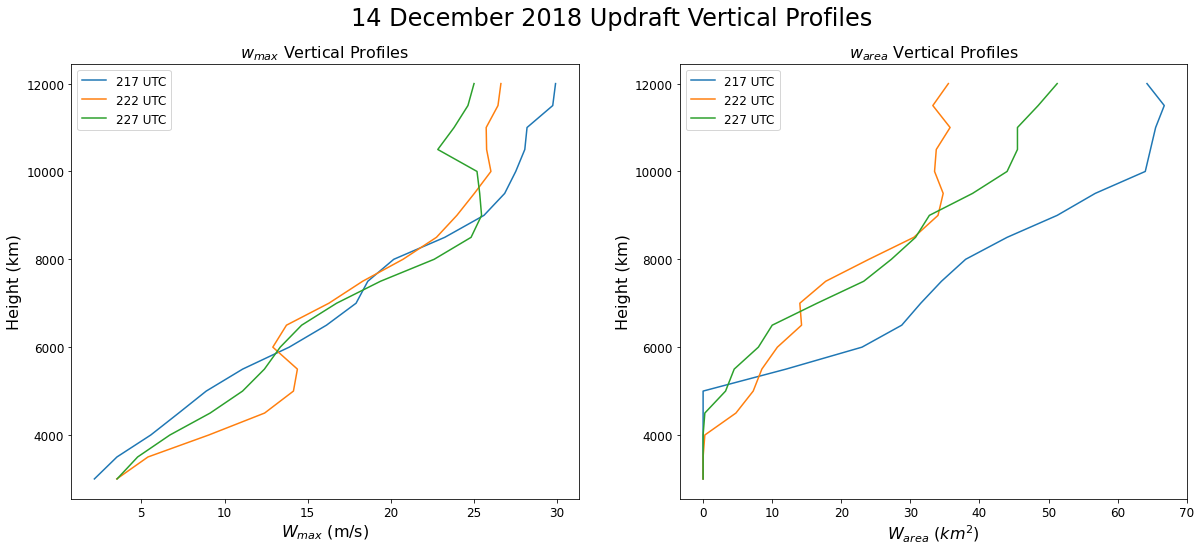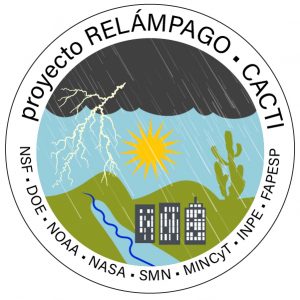Plot Dual Doppler Output
Contents
Plot Dual Doppler Output¶
import xarray as xr
import matplotlib.pyplot as plt
import pyart
import pandas as pd
import geopandas as gpd
import cartopy.crs as ccrs
import numpy as np
from shapely import wkt
def calc_updraft_area(vert_vel, threshold=2):
"""
Plots vertical profile of updraft area
"""
levels = vert_vel.z.values
areas = []
for lev in levels:
# Subset for given level
w_sub = vert_vel.sel(z=lev).values
# Calculate area by summing pixels exceeding threshold and multiply by area (.25 km2)
areas.append(len(w_sub[np.where(w_sub > threshold)]) * .25)
areas = np.array(areas)
return areas, levels
0226 UTC¶
ds = xr.open_dataset('dual_output/Nov12/new_cleaning/Nov12_0224.nc').squeeze()
w_vals = ds.where((ds.w > 0) & (ds.lat > -31.2) & (ds.lat < -31.13) & (ds.lon > -64.) & (ds.lon < -63.92)).sel(z=slice(5000, 12000)).w
w = ds.where((ds.w > 0) & (ds.lat > -31.2) & (ds.lat < -31.13) & (ds.lon > -64.) & (ds.lon < -63.92)).sel(z=slice(5000, 12000)).w.mean(dim='z').values
w_max = ds.where((ds.w > 0) & (ds.lat > -31.2) & (ds.lat < -31.13) & (ds.lon > -64.) & (ds.lon < -63.92)).sel(z=slice(5000, 12000)).w.max(dim=['x','y'])
ref = ds.sel(z=1500).ZM_composite.values
areas1, levels = calc_updraft_area(w_vals, 2)
wmax1 = w_max
/Users/mgrover/miniconda3/envs/unidata/lib/python3.7/site-packages/ipykernel_launcher.py:15: RuntimeWarning: invalid value encountered in greater
from ipykernel import kernelapp as app
plt.figure(figsize=(20,8))
ax = plt.subplot(121)
ax.plot(wmax1, levels, label='0226 UTC', color='tab:blue')
ax.plot(wmax2, levels, label='0232 UTC', color='tab:orange')
ax.plot(wmax3, levels, label='0236 UTC', color='tab:green')
plt.xticks(fontsize=12)
plt.yticks(fontsize=12)
plt.xlabel('$W_{max}$ (m/s)', fontsize=16)
plt.ylabel('Height (km)', fontsize=16)
plt.legend(loc='upper left', fontsize=14)
plt.title('12 November 2018 $w_{max}$ Vertical Profiles', fontsize=18)
ax2 = plt.subplot(122)
ax2.plot(areas1, levels, label='0226 UTC', color='tab:blue')
ax2.plot(areas2, levels, label='0232 UTC', color='tab:orange')
ax2.plot(areas3, levels, label='0236 UTC', color='tab:green')
plt.xticks(fontsize=12)
plt.yticks(fontsize=12)
plt.xlabel('$W_{area}$ ($km^2$)', fontsize=16)
plt.ylabel('Height (km)', fontsize=16)
plt.legend(loc='upper left', fontsize=14)
plt.title('12 November 2018 $w_{area}$ Vertical Profiles', fontsize=18)
---------------------------------------------------------------------------
NameError Traceback (most recent call last)
<ipython-input-7-030845936181> in <module>
3
4 ax.plot(wmax1, levels, label='0226 UTC', color='tab:blue')
----> 5 ax.plot(wmax2, levels, label='0232 UTC', color='tab:orange')
6 ax.plot(wmax3, levels, label='0236 UTC', color='tab:green')
7
NameError: name 'wmax2' is not defined

plt.plot(wmax1, levels, label='0226 UTC')
plt.plot(wmax2, levels, label='0232 UTC')
plt.plot(wmax3, levels, label='0236 UTC')
plt.legend()
---------------------------------------------------------------------------
NameError Traceback (most recent call last)
<ipython-input-7-be93dee9bc90> in <module>
1 plt.plot(wmax1, levels, label='0226 UTC')
----> 2 plt.plot(wmax2, levels, label='0232 UTC')
3 plt.plot(wmax3, levels, label='0236 UTC')
4
5 plt.legend()
NameError: name 'wmax2' is not defined
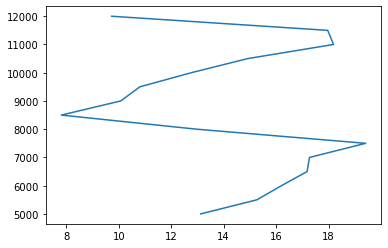
ds = xr.open_dataset('dual_output/Nov12/new_cleaning/Nov12_0220.nc').squeeze()
df = pd.read_csv('../radar_data_cleaning/Nov_12_2018_0227_0237_OTs.csv')
df['geometry'] = df['geometry'].apply(wkt.loads)
geo_df = gpd.GeoDataFrame(df, geometry='geometry')
lat_min = -31.19
lat_max = -31.13
lon_min = -63.8
lon_max = -63.7
ot_df = geo_df[df.minute == 27]
ota = ot_df.area_polygon.values
ot_lon = ot_df.centroid.x.values[0]
ot_lat = ot_df.centroid.y.values[0]
shift_x = ot_df.lon_corr.values[0] - ot_lon
shift_y = ot_df.lat_corr.values[0] - ot_lat
ot_df = ot_df.translate(shift_x, shift_y)
lats = ds.lat.values
lons = ds.lon.values
w_vals = ds.where((ds.w > 0) & (ds.lat > lat_min) & (ds.lat < lat_max) & (ds.lon > lon_min) & (ds.lon < lon_max)).sel(z=slice(5000, 10000)).w
w = ds.where((ds.w > 0) & (ds.lat > lat_min) & (ds.lat < lat_max) & (ds.lon > lon_min) & (ds.lon < lon_max)).sel(z=slice(5000, 10000)).w.mean(dim='z').values
w_max = ds.where((ds.w > 0) & (ds.lat > -31.25) & (ds.lat < -31.2) & (ds.lon > -64.) & (ds.lon < -63.9)).sel(z=slice(5000, 10000)).w.max(dim=['x','y'])
ref = ds.sel(z=3000).ZM_composite.values
area = len(w[np.where(w > 6)]) * .25
areas1, levels = calc_updraft_area(w_vals, 6)
wmax1 = w_max
/Users/mgrover/miniconda3/envs/unidata/lib/python3.7/site-packages/ipykernel_launcher.py:31: RuntimeWarning: invalid value encountered in greater
/Users/mgrover/miniconda3/envs/unidata/lib/python3.7/site-packages/ipykernel_launcher.py:15: RuntimeWarning: invalid value encountered in greater
from ipykernel import kernelapp as app
fig = plt.figure(figsize=(12,8))
ax = plt.subplot(111, projection=ccrs.PlateCarree())
cf = plt.pcolormesh(lons, lats,ref , vmin=10, vmax=60, cmap='pyart_HomeyerRainbow')
cb1 = plt.colorbar(cf, shrink=.7)
cb1.set_label('Reflectivity (dBZ)', fontsize=16)
cb1.ax.tick_params(labelsize=16)
#q = ax.quiver(lons[::2], lats[::2], u_wnd[::2], v_wnd[::2], pivot='mid', color='black', scale=50, scale_units='inches')
#ax.quiverkey(q, X=.95, Y=.1, U=10, label='10 m/s', labelpos='W')
w_mask = np.nan_to_num(w)
cf = plt.contour(lons, lats, w_mask , levels=[5, 30], colors=['black'], linestyles='dashed')
#plt.colorbar(cf, label='Vertical Velocity (m/s)', shrink=.7)
#ot_df.plot(ax=ax, facecolor="none",
# edgecolor='black',linewidth=3, label='otarea')
gl = ax.gridlines(crs=ccrs.PlateCarree(), draw_labels=True,
linewidth=2, color='gray', alpha=0.5, linestyle='--')
gl.top_labels = False
gl.left_labels= True
gl.right_labels = False
ax.set_extent((-64.25, -63.65, -31.5, -31.))
#plt.plot(0,0, color='black', label=f'OT Area: {ota[0].round(2)} $km^{2}$ ', linewidth=3)
plt.plot(0,0, color='black', label=f'Updraft Area: {area} $km^{2}$', linewidth=3, linestyle='--')
plt.legend(loc='upper left', fontsize=16)
plt.title('Reflectivity at 1.5 km \n and Mean Updraft 5-10 km \n 12 November 2018 0222 UTC', fontsize=18)
Text(0.5, 1.0, 'Reflectivity at 1.5 km \n and Mean Updraft 5-10 km \n 12 November 2018 0222 UTC')
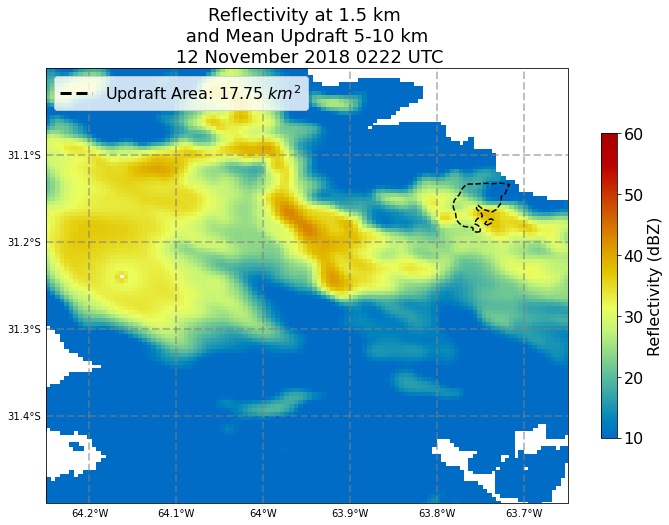
ds = xr.open_dataset('dual_output/Nov12/new_cleaning/Nov12_0224.nc').squeeze()
df = pd.read_csv('../radar_data_cleaning/Nov_12_2018_0227_0237_OTs.csv')
df['geometry'] = df['geometry'].apply(wkt.loads)
geo_df = gpd.GeoDataFrame(df, geometry='geometry')
lat_min = -31.25
lat_max = -31.16
lon_min = -63.8
lon_max = -63.65
ot_df = geo_df[df.minute == 27]
ota = ot_df.area_polygon.values
ot_lon = ot_df.centroid.x.values[0]
ot_lat = ot_df.centroid.y.values[0]
shift_x = ot_df.lon_corr.values[0] - ot_lon
shift_y = ot_df.lat_corr.values[0] - ot_lat
ot_df = ot_df.translate(shift_x, shift_y)
lats = ds.lat.values
lons = ds.lon.values
w_vals = ds.where((ds.w > 0) & (ds.lat > lat_min) & (ds.lat < lat_max) & (ds.lon > lon_min) & (ds.lon < lon_max)).sel(z=slice(5000, 10000)).w
w = ds.where((ds.w > 0) & (ds.lat > lat_min) & (ds.lat < lat_max) & (ds.lon > lon_min) & (ds.lon < lon_max)).sel(z=slice(5000, 10000)).w.mean(dim='z').values
w_max = ds.where((ds.w > 0) & (ds.lat > lat_min) & (ds.lat < lat_max) & (ds.lon > lon_min) & (ds.lon < lon_max)).sel(z=slice(5000, 10000)).w.max(dim=['x','y'])
ref = ds.sel(z=3000).ZM_composite.values
area = len(w[np.where(w > 6)]) * .25
areas2, levels = calc_updraft_area(w_vals, 6)
wmax2 = w_max
/Users/mgrover/miniconda3/envs/unidata/lib/python3.7/site-packages/ipykernel_launcher.py:31: RuntimeWarning: invalid value encountered in greater
/Users/mgrover/miniconda3/envs/unidata/lib/python3.7/site-packages/ipykernel_launcher.py:15: RuntimeWarning: invalid value encountered in greater
from ipykernel import kernelapp as app
fig = plt.figure(figsize=(12,8))
ax = plt.subplot(111, projection=ccrs.PlateCarree())
cf = plt.pcolormesh(lons, lats,ref , vmin=10, vmax=60, cmap='pyart_HomeyerRainbow')
cb1 = plt.colorbar(cf, shrink=.7)
cb1.set_label('Reflectivity (dBZ)', fontsize=16)
cb1.ax.tick_params(labelsize=16)
#q = ax.quiver(lons[::2], lats[::2], u_wnd[::2], v_wnd[::2], pivot='mid', color='black', scale=50, scale_units='inches')
#ax.quiverkey(q, X=.95, Y=.1, U=10, label='10 m/s', labelpos='W')
w_mask = np.nan_to_num(w)
cf = plt.contour(lons, lats, w_mask , levels=[5, 30], colors=['black'], linestyles='dashed')
#plt.colorbar(cf, label='Vertical Velocity (m/s)', shrink=.7)
ot_df.plot(ax=ax, facecolor="none",
edgecolor='black',linewidth=3, label='otarea')
gl = ax.gridlines(crs=ccrs.PlateCarree(), draw_labels=True,
linewidth=2, color='gray', alpha=0.5, linestyle='--')
gl.top_labels = False
gl.left_labels= True
gl.right_labels = False
ax.set_extent((-64.25, -63.65, -31.5, -31.))
plt.plot(0,0, color='black', label=f'OT Area: {ota[0].round(2)} $km^{2}$ ', linewidth=3)
plt.plot(0,0, color='black', label=f'Updraft Area: {area} $km^{2}$', linewidth=3, linestyle='--')
plt.legend(loc='upper left', fontsize=16)
plt.title('Reflectivity at 1.5 km \n and Mean Updraft 5-10 km \n 12 November 2018 0226 UTC', fontsize=18)
Text(0.5, 1.0, 'Reflectivity at 1.5 km \n and Mean Updraft 5-10 km \n 12 November 2018 0226 UTC')

ds = xr.open_dataset('dual_output/Nov12/new_cleaning/Nov12_0230.nc').squeeze()
df = pd.read_csv('../radar_data_cleaning/Nov_12_2018_0227_0237_OTs.csv')
df['geometry'] = df['geometry'].apply(wkt.loads)
geo_df = gpd.GeoDataFrame(df, geometry='geometry')
lat_min = -31.3
lat_max = -31.22
lon_min = -63.8
lon_max = -63.66
ot_df = geo_df[df.minute == 31]
ota = ot_df.area_polygon.values
ot_lon = ot_df.centroid.x.values[0]
ot_lat = ot_df.centroid.y.values[0]
shift_x = ot_df.lon_corr.values[0] - ot_lon
shift_y = ot_df.lat_corr.values[0] - ot_lat
ot_df = ot_df.translate(shift_x, shift_y)
lats = ds.lat.values
lons = ds.lon.values
w_vals = ds.where((ds.w > 0) & (ds.lat > lat_min) & (ds.lat < lat_max) & (ds.lon > lon_min) & (ds.lon < lon_max)).sel(z=slice(5000, 10000)).w
w = ds.where((ds.w > 0) & (ds.lat > lat_min) & (ds.lat < lat_max) & (ds.lon > lon_min) & (ds.lon < lon_max)).sel(z=slice(5000, 10000)).w.mean(dim='z').values
w_max = ds.where((ds.w > 0) & (ds.lat > lat_min) & (ds.lat < lat_max) & (ds.lon > lon_min) & (ds.lon < lon_max)).sel(z=slice(5000, 10000)).w.max(dim=['x','y'])
ref = ds.sel(z=3000).ZM_composite.values
area = len(w[np.where(w > 6)]) * .25
areas3, levels = calc_updraft_area(w_vals, 6)
wmax3 = w_max
/Users/mgrover/miniconda3/envs/unidata/lib/python3.7/site-packages/ipykernel_launcher.py:31: RuntimeWarning: invalid value encountered in greater
/Users/mgrover/miniconda3/envs/unidata/lib/python3.7/site-packages/ipykernel_launcher.py:15: RuntimeWarning: invalid value encountered in greater
from ipykernel import kernelapp as app
fig = plt.figure(figsize=(12,8))
ax = plt.subplot(111, projection=ccrs.PlateCarree())
cf = plt.pcolormesh(lons, lats,ref , vmin=10, vmax=50, cmap='pyart_HomeyerRainbow')
cb1 = plt.colorbar(cf, shrink=.7)
cb1.set_label('Reflectivity (dBZ)', fontsize=16)
cb1.ax.tick_params(labelsize=16)
#q = ax.quiver(lons[::2], lats[::2], u_wnd[::2], v_wnd[::2], pivot='mid', color='black', scale=50, scale_units='inches')
#ax.quiverkey(q, X=.95, Y=.1, U=10, label='10 m/s', labelpos='W')
w_mask = np.nan_to_num(w)
cf = plt.contour(lons, lats, w_mask , levels=[5, 30], colors=['black'], linestyles='dashed')
#plt.colorbar(cf, label='Vertical Velocity (m/s)', shrink=.7)
ot_df.plot(ax=ax, facecolor="none",
edgecolor='black',linewidth=3, label='otarea')
gl = ax.gridlines(crs=ccrs.PlateCarree(), draw_labels=True,
linewidth=2, color='gray', alpha=0.5, linestyle='--')
gl.top_labels = False
gl.left_labels= True
gl.right_labels = False
ax.set_extent((-64.25, -63.65, -31.5, -31.))
plt.plot(0,0, color='black', label=f'OT Area: {ota[0].round(2)} $km^{2}$ ', linewidth=3)
plt.plot(0,0, color='black', label=f'Updraft Area: {area} $km^{2}$', linewidth=3, linestyle='--')
plt.legend(loc='upper left', fontsize=16)
plt.title('Reflectivity at 1.5 km \n and Mean Updraft 5-10 km \n 12 November 2018 0232 UTC', fontsize=18)
Text(0.5, 1.0, 'Reflectivity at 1.5 km \n and Mean Updraft 5-10 km \n 12 November 2018 0232 UTC')
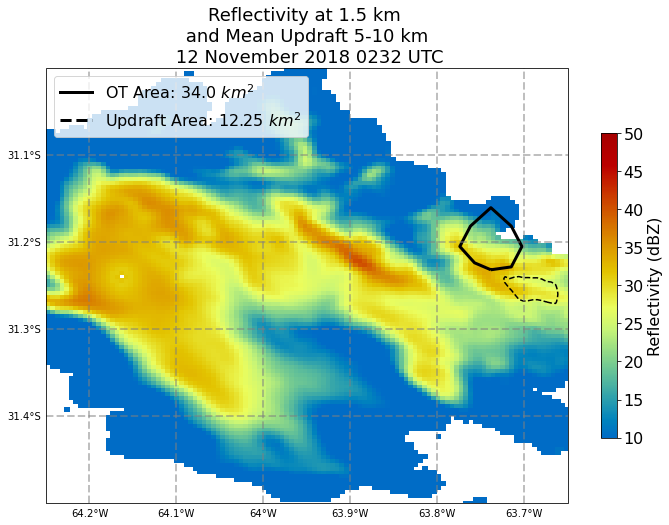
plt.figure(figsize=(20,8))
ax = plt.subplot(121)
ax.plot(wmax1, levels, label='0222 UTC', color='tab:blue')
ax.plot(wmax2, levels, label='0226 UTC', color='tab:orange')
ax.plot(wmax3, levels, label='0232 UTC', color='tab:green')
plt.xticks(fontsize=12)
plt.yticks(fontsize=12)
plt.xlabel('$W_{max}$ (m/s)', fontsize=16)
plt.ylabel('Height (km)', fontsize=16)
plt.legend(loc='upper left', fontsize=14)
plt.title('12 November 2018 $w_{max}$ Vertical Profiles', fontsize=18)
ax2 = plt.subplot(122)
ax2.plot(areas1, levels, label='0222 UTC', color='tab:blue')
ax2.plot(areas2, levels, label='0226 UTC', color='tab:orange')
ax2.plot(areas3, levels, label='0232 UTC', color='tab:green')
plt.xticks(fontsize=12)
plt.yticks(fontsize=12)
plt.xlabel('$W_{area}$ ($km^2$)', fontsize=16)
plt.ylabel('Height (km)', fontsize=16)
plt.legend(loc='upper left', fontsize=14)
plt.title('12 November 2018 $w_{area}$ Vertical Profiles', fontsize=18)
---------------------------------------------------------------------------
NameError Traceback (most recent call last)
<ipython-input-19-4cc26b9ec3f9> in <module>
3
4 ax.plot(wmax1, levels, label='0222 UTC', color='tab:blue')
----> 5 ax.plot(wmax2, levels, label='0226 UTC', color='tab:orange')
6 ax.plot(wmax3, levels, label='0232 UTC', color='tab:green')
7
NameError: name 'wmax2' is not defined
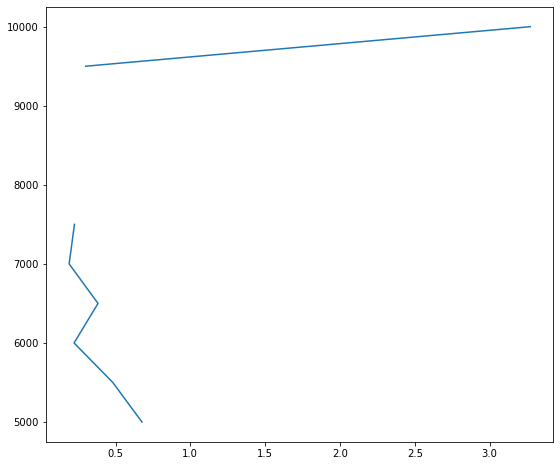
ds = xr.open_dataset('dual_output/Nov12/new_cleaning/Nov12_0244.nc').squeeze()
#df = pd.read_csv('../radar_data_cleaning/Nov_12_2018_0227_0237_OTs.csv')
df = pd.read_csv('ot_output/Revised_OTs_12_Nov_2018_0232_0243.csv')
df['time'] = pd.to_datetime(df.time)
df['minute'] = df.time.dt.minute
df['geometry'] = df['geometry'].apply(wkt.loads)
geo_df = gpd.GeoDataFrame(df, geometry='geometry')
lat_min = -31.4
lat_max = -31.15
lon_min = -64.3
lon_max = -63.9
ot_df = geo_df[df.minute == 44]
ota = ot_df.area_circle_polygon.values
ot_lon = ot_df.centroid.x.values[0]
ot_lat = ot_df.centroid.y.values[0]
shift_x = ot_df.lon_corr.values[0] - ot_lon
shift_y = ot_df.lat_corr.values[0] - ot_lat
ot_df = ot_df.translate(shift_x, shift_y)
lats = ds.lat.values
lons = ds.lon.values
w_vals = ds.where((ds.w > 0) & (ds.lat > lat_min) & (ds.lat < lat_max) & (ds.lon > lon_min) & (ds.lon < lon_max)).sel(z=slice(5000, 8000)).w
w = ds.where((ds.w > 0) & (ds.lat > lat_min) & (ds.lat < lat_max) & (ds.lon > lon_min) & (ds.lon < lon_max)).sel(z=slice(5000, 10000)).w.mean(dim='z').values
w_max = ds.where((ds.w > 0) & (ds.lat > lat_min) & (ds.lat < lat_max) & (ds.lon > lon_min) & (ds.lon < lon_max)).sel(z=slice(5000, 10000)).w.max(dim=['x','y'])
ref = ds.sel(z=1500).ZM_composite.values
area = len(w[np.where(w > 2)]) * .25
---------------------------------------------------------------------------
IndexError Traceback (most recent call last)
<ipython-input-46-c6cbba4db03b> in <module>
16 ota = ot_df.area_circle_polygon.values
17
---> 18 ot_lon = ot_df.centroid.x.values[0]
19 ot_lat = ot_df.centroid.y.values[0]
20
IndexError: index 0 is out of bounds for axis 0 with size 0
np.nanpercentile(w, 70)
2.9094482063830123
fig = plt.figure(figsize=(12,8))
ax = plt.subplot(111, projection=ccrs.PlateCarree())
cf = plt.pcolormesh(lons, lats,ref , vmin=10, vmax=50, cmap='pyart_HomeyerRainbow')
cb1 = plt.colorbar(cf, shrink=.7)
cb1.set_label('Reflectivity (dBZ)', fontsize=16)
cb1.ax.tick_params(labelsize=16)
#q = ax.quiver(lons[::2], lats[::2], u_wnd[::2], v_wnd[::2], pivot='mid', color='black', scale=50, scale_units='inches')
#ax.quiverkey(q, X=.95, Y=.1, U=10, label='10 m/s', labelpos='W')
w_mask = np.nan_to_num(w)
cf = plt.contour(lons, lats, w_mask , levels=[2, 6, 12], colors=['black'], linestyles='dashed')
#plt.colorbar(cf, label='Vertical Velocity (m/s)', shrink=.7)
ot_df.plot(ax=ax, facecolor="none",
edgecolor='black',linewidth=3, label='otarea')
gl = ax.gridlines(crs=ccrs.PlateCarree(), draw_labels=True,
linewidth=2, color='gray', alpha=0.5, linestyle='--')
gl.top_labels = False
gl.left_labels= True
gl.right_labels = False
ax.set_extent((-64.25, -63.65, -31.5, -31.))
plt.plot(0,0, color='black', label=f'OT Area: {ota[0].round(2)} $km^{2}$ ', linewidth=3)
plt.plot(0,0, color='black', label=f'Updraft Area: {area} $km^{2}$', linewidth=3, linestyle='--')
plt.legend(loc='upper left', fontsize=16)
plt.title('Reflectivity at 1.5 km \n and Mean Updraft 5-10 km \n 12 November 2018 0242 UTC', fontsize=18)
/Users/mgrover/miniconda3/envs/unidata/lib/python3.7/site-packages/geopandas/plotting.py:607: UserWarning: The GeoDataFrame you are attempting to plot is empty. Nothing has been displayed.
UserWarning,
---------------------------------------------------------------------------
IndexError Traceback (most recent call last)
<ipython-input-48-bed59bee15f6> in <module>
27 ax.set_extent((-64.25, -63.65, -31.5, -31.))
28
---> 29 plt.plot(0,0, color='black', label=f'OT Area: {ota[0].round(2)} $km^{2}$ ', linewidth=3)
30 plt.plot(0,0, color='black', label=f'Updraft Area: {area} $km^{2}$', linewidth=3, linestyle='--')
31
IndexError: index 0 is out of bounds for axis 0 with size 0
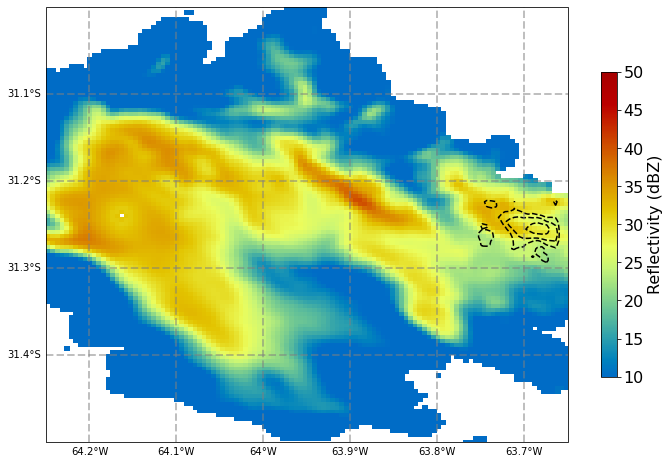
df = pd.read_csv('ot_output/Revised_OTs_12_Nov_2018_0232_0243.csv', index_col='time', parse_dates=True)
df['ot_depth'] = df.cloudtop_height - df.tropopause_height
from datetime import timedelta
df.index = df.index + timedelta(minutes=1)
df['minute'] = df.index.minute
df['btd'] = df.tropopause_temperature - df.mintb
df.btd
time
2018-11-12 02:32:54.000000000 1.030014
2018-11-12 02:33:54.000000000 -0.869995
2018-11-12 02:34:54.000000000 2.240005
2018-11-12 02:35:54.000000000 3.010010
2018-11-12 02:38:54.000000000 -1.929993
2018-11-12 02:39:54.000000000 -1.179993
2018-11-12 02:40:54.000000000 -0.599991
2018-11-12 02:41:54.000001024 -2.479996
2018-11-12 02:42:54.000000000 -2.000000
2018-11-12 02:43:54.000000000 -1.580002
Name: btd, dtype: float64
df_sub = geo_df[df.minute == 33]
ot_df = df_sub[df_sub.lat == df_sub.lat.values[0]]
ot_lon = df_sub.lon.values[0]
ot_lat = df_sub.lat.values[0]
shift_x = ot_df.lon_corr.values[0] - ot_lon
shift_y = ot_df.lat_corr.values[0] - ot_lat
/Users/mgrover/miniconda3/envs/unidata/lib/python3.7/site-packages/geopandas/geodataframe.py:828: UserWarning: Boolean Series key will be reindexed to match DataFrame index.
result = super(GeoDataFrame, self).__getitem__(key)
---------------------------------------------------------------------------
IndexingError Traceback (most recent call last)
<ipython-input-194-a828582516e4> in <module>
----> 1 df_sub = geo_df[df.minute == 33]
2 ot_df = df_sub[df_sub.lat == df_sub.lat.values[0]]
3
4 ot_lon = df_sub.lon.values[0]
5 ot_lat = df_sub.lat.values[0]
~/miniconda3/envs/unidata/lib/python3.7/site-packages/geopandas/geodataframe.py in __getitem__(self, key)
826 GeoDataFrame.
827 """
--> 828 result = super(GeoDataFrame, self).__getitem__(key)
829 geo_col = self._geometry_column_name
830 if isinstance(result, Series) and isinstance(result.dtype, GeometryDtype):
~/miniconda3/envs/unidata/lib/python3.7/site-packages/pandas/core/frame.py in __getitem__(self, key)
2888 # Do we have a (boolean) 1d indexer?
2889 if com.is_bool_indexer(key):
-> 2890 return self._getitem_bool_array(key)
2891
2892 # We are left with two options: a single key, and a collection of keys,
~/miniconda3/envs/unidata/lib/python3.7/site-packages/pandas/core/frame.py in _getitem_bool_array(self, key)
2940 # check_bool_indexer will throw exception if Series key cannot
2941 # be reindexed to match DataFrame rows
-> 2942 key = check_bool_indexer(self.index, key)
2943 indexer = key.nonzero()[0]
2944 return self._take_with_is_copy(indexer, axis=0)
~/miniconda3/envs/unidata/lib/python3.7/site-packages/pandas/core/indexing.py in check_bool_indexer(index, key)
2183 if mask.any():
2184 raise IndexingError(
-> 2185 "Unalignable boolean Series provided as "
2186 "indexer (index of the boolean Series and of "
2187 "the indexed object do not match)."
IndexingError: Unalignable boolean Series provided as indexer (index of the boolean Series and of the indexed object do not match).
df.lat_corr.values[0]
-33.08235549926758
ds = xr.open_dataset('dual_output/Nov12/man_edited_Nov12_0230.nc').squeeze()
#ds = xr.open_dataset('dual_output/Nov12/new_cleaning/Nov12_0230.nc').squeeze()
from shapely import wkt
df['geometry'] = df['geometry'].apply(wkt.loads)
geo_df = gpd.GeoDataFrame(df, geometry='geometry')
df_sub = geo_df[df.minute == 32]
ot_df = df_sub[df_sub.lat == df_sub.lat.values[0]]
ota = ot_df.area_circle_polygon.values
ot_lon = df_sub.lon.values[0]
ot_lat = df_sub.lat.values[0]
ot_df = ot_df.translate(shift_x, shift_y)
lats = ds.lat.values
lons = ds.lon.values
w_vals = ds.where((ds.w > 0) & (ds.lat > -31.25) & (ds.lat < -31.2) & (ds.lon > -64.) & (ds.lon < -63.9)).sel(z=slice(3000, 12000)).w
areas1, levels = calc_updraft_area(w_vals, 2)
/Users/mgrover/miniconda3/envs/unidata/lib/python3.7/site-packages/ipykernel_launcher.py:15: RuntimeWarning: invalid value encountered in greater
from ipykernel import kernelapp as app
plt.plot(areas1, levels)
[<matplotlib.lines.Line2D at 0x7fdad5c06c50>]
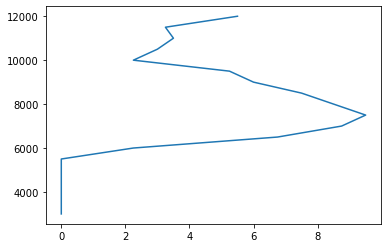
# (ds.lat > -31.2) & (ds.lat < -31.13) & (ds.lon > -64.1) & (ds.lon < -63.95)
w_vals = ds.where((ds.w > 0) & (ds.lat > -31.19) & (ds.lat < -31.14) & (ds.lon > -64.) & (ds.lon < -63.915)).sel(z=slice(3000, 12000)).w
w = ds.where((ds.w > 0) & (ds.lat > -31.19) & (ds.lat < -31.14) & (ds.lon > -64.) & (ds.lon < -63.915)).sel(z=slice(5000, 10000)).w.mean(dim='z').values
w_max = ds.where((ds.w > 0) & (ds.lat > -31.25) & (ds.lat < -31.19) & (ds.lon > -64.) & (ds.lon < -63.89)).sel(z=slice(3000, 12000)).w.max(dim=['x','y'])
ref = ds.sel(z=1500).ZM_composite.values
area = len(w[np.where(w > 2)]) * .25
mean_w = np.nanmean(w[np.where(w > 2)])
/Users/mgrover/miniconda3/envs/unidata/lib/python3.7/site-packages/ipykernel_launcher.py:7: RuntimeWarning: invalid value encountered in greater
import sys
/Users/mgrover/miniconda3/envs/unidata/lib/python3.7/site-packages/ipykernel_launcher.py:8: RuntimeWarning: invalid value encountered in greater
print(mean_w)
3.3403468136993064
max_w = np.nanmax(w_max)
mean_w = np.nanmean(w_max)
max_w2 = np.nanmax(wmax_2)
mean_w2 = np.nanmean(wmax_2)
---------------------------------------------------------------------------
NameError Traceback (most recent call last)
<ipython-input-39-3c218ed79a0d> in <module>
2 mean_w = np.nanmean(w_max)
3
----> 4 max_w2 = np.nanmax(wmax_2)
5 mean_w2 = np.nanmean(wmax_2)
NameError: name 'wmax_2' is not defined
max_w
14.35641200781719
fig = plt.figure(figsize=(20,8))
ax = plt.subplot(121)
ax.plot(w_max.values, w_max.z, label='0232 UTC', color='tab:blue')
#plt.axvline(max_w, label=f'Max w in 5-10 km layer {np.round(max_w, 2)} m/s', linestyle='--', color='tab:blue')
#plt.axvline(mean_w, label=f'Mean w in 5-10 km layer {np.round(mean_w, 2)} m/s', linestyle=':', color='tab:blue')
ax.plot(wmax_2.values, w_max.z, label='0236 UTC', color='tab:orange')
#plt.axvline(max_w2, label=f'Max w in 5-10 km layer {np.round(max_w2, 2)} m/s', linestyle='--', color='tab:orange')
#plt.axvline(mean_w2, label=f'Mean w in 5-10 km layer {np.round(mean_w2, 2)} m/s', linestyle=':', color='tab:orange')
plt.xticks(fontsize=12)
plt.yticks(fontsize=12)
plt.xlabel('$W_{max}$ (m/s)', fontsize=16)
plt.ylabel('Height (km)', fontsize=16)
plt.legend(loc='upper left', fontsize=14)
plt.title('12 November 2018 $w_{max}$ Vertical Profiles', fontsize=18)
ax2 = plt.subplot(122)
ax2.plot(areas1, w_max.z, label='0232 UTC', color='tab:blue')
ax2.plot(areas2, w_max.z, label='0236 UTC', color='tab:orange')
plt.xticks(fontsize=12)
plt.yticks(fontsize=12)
plt.xlabel('$W_{area}$ ($km^2$)', fontsize=16)
plt.ylabel('Height (km)', fontsize=16)
plt.legend(loc='upper left', fontsize=14)
plt.title('12 November 2018 $w_{area}$ Vertical Profiles', fontsize=18)
plt.suptitle('12 November 2018 Updraft Vertical Profiles', fontsize=24)
plt.savefig('Vertical_w_prof_12_nov.png', dpi=400)
---------------------------------------------------------------------------
NameError Traceback (most recent call last)
<ipython-input-142-5afd0d603426> in <module>
7 #plt.axvline(mean_w, label=f'Mean w in 5-10 km layer {np.round(mean_w, 2)} m/s', linestyle=':', color='tab:blue')
8
----> 9 ax.plot(wmax_2.values, w_max.z, label='0236 UTC', color='tab:orange')
10 #plt.axvline(max_w2, label=f'Max w in 5-10 km layer {np.round(max_w2, 2)} m/s', linestyle='--', color='tab:orange')
11 #plt.axvline(mean_w2, label=f'Mean w in 5-10 km layer {np.round(mean_w2, 2)} m/s', linestyle=':', color='tab:orange')
NameError: name 'wmax_2' is not defined
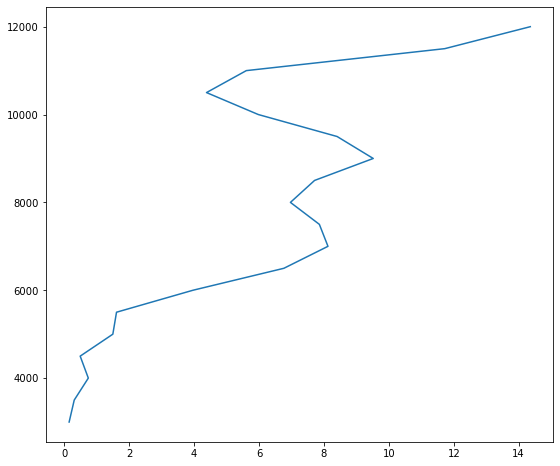
fig = plt.figure(figsize=(12,8))
ax = plt.subplot(111, projection=ccrs.PlateCarree())
cf = plt.pcolormesh(lons, lats,ref , vmin=10, vmax=50, cmap='pyart_Carbone17')
cb1 = plt.colorbar(cf, shrink=.7)
cb1.set_label('Reflectivity (dBZ)', fontsize=16)
cb1.ax.tick_params(labelsize=16)
#q = ax.quiver(lons[::2], lats[::2], u_wnd[::2], v_wnd[::2], pivot='mid', color='black', scale=50, scale_units='inches')
#ax.quiverkey(q, X=.95, Y=.1, U=10, label='10 m/s', labelpos='W')
w_mask = np.nan_to_num(w)
cf = plt.contour(lons, lats, w_mask , levels=[2, 30], colors=['black'], linestyles='dashed')
#plt.colorbar(cf, label='Vertical Velocity (m/s)', shrink=.7)
ot_df.plot(ax=ax, facecolor="none",
edgecolor='black',linewidth=3, label='otarea')
gl = ax.gridlines(crs=ccrs.PlateCarree(), draw_labels=True,
linewidth=2, color='gray', alpha=0.5, linestyle='--')
gl.top_labels = False
gl.left_labels= True
gl.right_labels = False
ax.set_extent((-64.25, -63.8, -31.5, -31.1))
plt.plot(0,0, color='black', label=f'OT Area: {ota[0].round(2)} $km^{2}$ ', linewidth=3)
plt.plot(0,0, color='black', label=f'Updraft Area: {area} $km^{2}$', linewidth=3, linestyle='--')
plt.legend(loc='upper left', fontsize=16)
plt.title('Reflectivity at 1.5 km \n and Mean Updraft 5-10 km \n 12 November 2018 0232 UTC', fontsize=18)
plt.savefig('summary_figs/Nov_12_2018_0230.png', dpi=300)
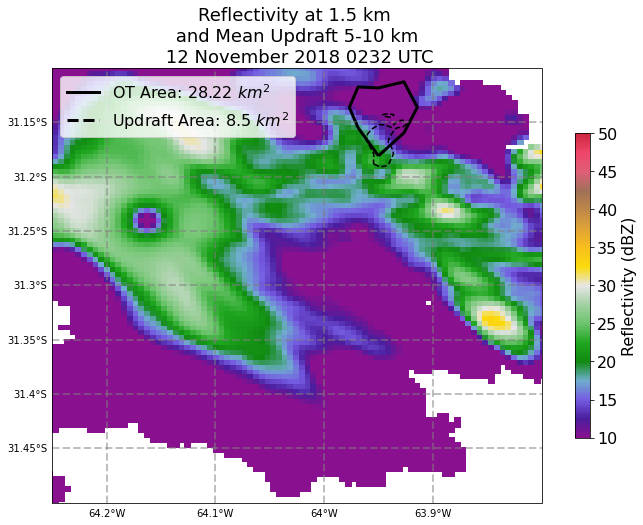
np.nanpercentile(w, 70)
2.1864180772879176
geo_df = geo_df[(geo_df.minute >= 32) & (geo_df.minute <= 36)]
geo_df['times'] = geo_df.index.strftime('%H%M')
geo_df['times'] = geo_df.times.astype(int)
trop_temps = geo_df.tropopause_temperature.values
trop_height = geo_df.tropopause_height.values
ct_height = geo_df.cloudtop_height.values
ot_temp = geo_df.mintb.values
btd = ot_temp - trop_temps
depth = ct_height - trop_height
nov12_times = np.array([int(232), int(236)])
nov12_ua = [8.5, 11.75,]
nov12_wmax = [9.52, 10.76]
#nov12_ua = [14.5, 10.75,]
nov12_wmax = [9.52, 10.76]
ticks = np.append(geo_df.times, 236)
plt.figure(figsize=(16,9))
ax = plt.subplot(311)
ota = geo_df.area_circle_polygon
times = geo_df.times
ax.plot(geo_df.times, ota, linewidth=3, color='black')
max_ota = ota.max()
ind = np.where(ota == max_ota)[0][0]
#plt.axhline(ota[ind], linestyle='--', label=f'Max OTA {round(float(max_ota), 2)} $km^{2}$',
# color='k', linewidth=3)
#ax.scatter(df_sub.datetime, df_sub.area_polygon, s=80, color='black')
plt.yticks(fontsize=12)
plt.xticks(ticks, fontsize=12)
plt.ylabel('OTA \n $km^{2}$', fontsize=16)
ax_1 = plt.twinx()
ax_1.scatter(nov12_times, nov12_ua, linewidth=3, color='tab:blue', linestyle='-', label='Tropopause Height', s=50)
#ax_1.plot(geo_df.times, ota*.4032, linewidth=3, color='tab:blue', linestyle=':')
plt.ylabel('Updraft Area \n $km^{2}$', fontsize=16, color='tab:blue')
plt.xlabel('Time', fontsize=16)
plt.yticks(fontsize=12, color='tab:blue')
plt.yticks(fontsize=12)
plt.xticks(fontsize=12)
plt.xlim(231.5, 236.5)
#plt.legend(loc='lower left', fontsize=16)
ax2 = plt.subplot(312)
ax2.plot(times, btd, linewidth=3, color='black', linestyle='-', label='BTD')
#ax2.plot(times, ot_temp, linewidth=3, color='blue')
plt.yticks(fontsize=12)
plt.xticks(ticks, fontsize=12)
#ax2.scatter(df_sub.datetime, df_sub.mintb, s=80, color='black')
plt.ylabel('BTD \n $K$', fontsize=16)
plt.xlim(231.5, 236.5)
ax3 = plt.subplot(313)
ax3.plot(times, depth, linewidth=3, color='black', linestyle='-', label='Tropopause Height')
#ax3.plot(times, ct_height, linewidth=3, color='red')
#ax3.scatter(df_sub.datetime, df_sub.cloudtop_height.values[0], s=80, color='black')
plt.ylabel('OT Depth \n $km$', fontsize=16)
plt.xlabel('Time (UTC)', fontsize=16)
plt.yticks(fontsize=12)
plt.xticks(ticks, fontsize=12)
ax_3 = ax3.twinx()
ax_3.scatter(nov12_times, nov12_wmax, linewidth=3, color='tab:red', linestyle='-', label='Tropopause Height', s=50)
plt.ylabel('Max Updraft Speed \n $m/s$', fontsize=16, color='tab:red')
plt.xlabel('Time (UTC)', fontsize=16)
plt.yticks(fontsize=12, color='tab:red')
plt.xticks(fontsize=12, color='tab:red')
plt.xlim(231.5, 236.5)
#plt.legend(loc='lower left', fontsize=16)
#ax4 = plt.subplot(514)
#ax4.plot(nov12_times, nov12_ua, linewidth=3, color='tab:blue', linestyle='-', label='Tropopause Height')
#ax3.plot(times, ct_height, linewidth=3, color='red')
#plt.ylabel('Updraft Area \n $km^{2}$', fontsize=16)
#plt.xlabel('Time', fontsize=16)
#ax4 = plt.subplot(515)
#ax4.plot(nov12_times, nov12_wmax, linewidth=3, color='tab:green', linestyle='-', label='Tropopause Height')
#ax3.plot(times, ct_height, linewidth=3, color='red')
#plt.ylabel('Max Updraft Speed \n $m/s$', fontsize=16)
#plt.xlabel('Time', fontsize=16)
#plt.suptitle(f'10 November 2018 Supercell \n {df_sub.datetime.values[0]} UTC', fontsize=24)
#plt.savefig(f'compare_plots/time_series_{timestamp}.png', dpi=200)
#plt.suptitle()
plt.tight_layout()
plt.savefig('12_November_Time_Series.png', dpi=300)
plt.show()
plt.close()
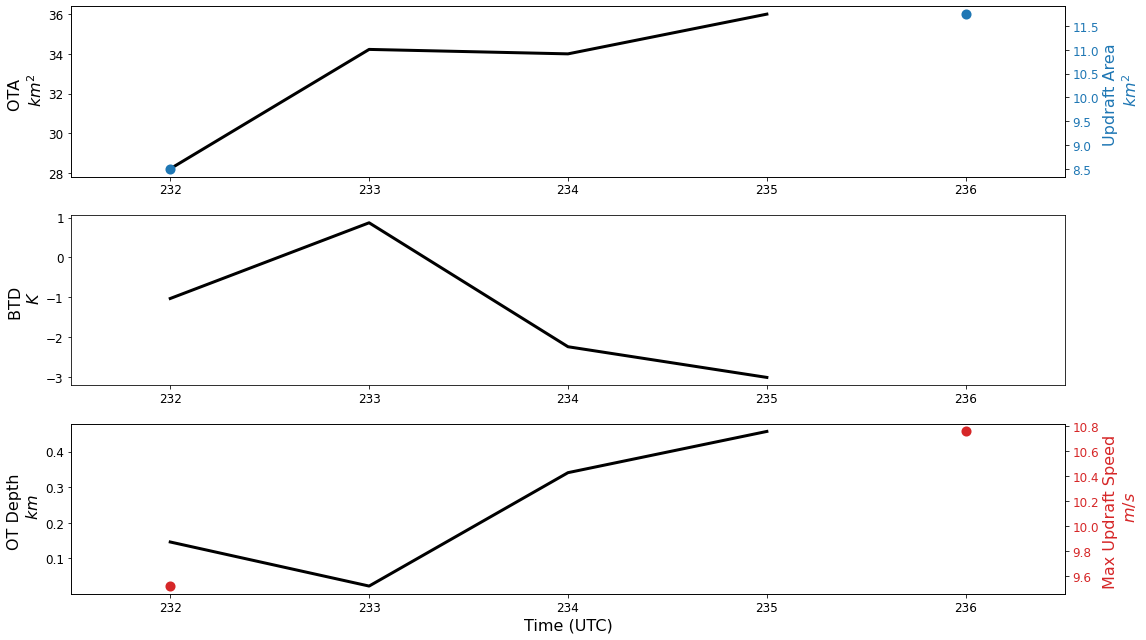
import numpy as np
len(w[np.where(w > 3)]) * .25
/Users/mgrover/miniconda3/envs/unidata/lib/python3.7/site-packages/ipykernel_launcher.py:2: RuntimeWarning: invalid value encountered in greater
4.5
np.nanpercentile(w, 95)
3.8927460060268086
w_test = ds.where(ds.w >0).sel(z=7000).w.values
np.nanpercentile(w, 90)
3.5118398595380564
0234 UTC¶
ds = xr.open_dataset('dual_output/Nov12/man_edited_Nov12_0234.nc').squeeze()
#ds = xr.open_dataset('dual_output/Nov12/new_cleaning/Nov12_0234.nc').squeeze()
df_sub = geo_df[df.minute == 35]
/Users/mgrover/miniconda3/envs/unidata/lib/python3.7/site-packages/geopandas/geodataframe.py:828: UserWarning: Boolean Series key will be reindexed to match DataFrame index.
result = super(GeoDataFrame, self).__getitem__(key)
ot_df = df_sub[df_sub.lat == df_sub.lat.values[0]]
ota = ot_df.area_circle_polygon.values
ot_df = ot_df.translate(shift_x, shift_y)
lats = ds.lat.values
lons = ds.lon.values
# (ds.lat > -31.2) & (ds.lat < -31.13) & (ds.lon > -64.1) & (ds.lon < -63.95)
w_vals = ds.where((ds.w > 0) & (ds.lat > -31.19) & (ds.lat < -31.14) & (ds.lon > -64.) & (ds.lon < -63.915)).sel(z=slice(3000, 12000)).w
w = ds.where((ds.w > 0) & (ds.lat > -31.19) & (ds.lat < -31.14) & (ds.lon > -64.) & (ds.lon < -63.915)).sel(z=slice(5000, 10000)).w.mean(dim='z').values
w_max = ds.where((ds.w > 0) & (ds.lat > -31.19) & (ds.lat < -31.14) & (ds.lon > -64.) & (ds.lon < -63.915)).sel(z=slice(3000, 12000)).w.max(dim=['x','y'])
ref = ds.sel(z=1500).ZM_composite.values
area = len(w[np.where(w > 2)]) * .25
w_mean = np.nanmean(w[np.where(w > 2)])
/Users/mgrover/miniconda3/envs/unidata/lib/python3.7/site-packages/ipykernel_launcher.py:1: RuntimeWarning: invalid value encountered in greater
"""Entry point for launching an IPython kernel.
/Users/mgrover/miniconda3/envs/unidata/lib/python3.7/site-packages/ipykernel_launcher.py:2: RuntimeWarning: invalid value encountered in greater
print(w_mean)
3.37020812274877
wmax_2 = w_max
areas2, levels = calc_updraft_area(w_vals, 2)
np.nanmax(w_max)
/Users/mgrover/miniconda3/envs/unidata/lib/python3.7/site-packages/ipykernel_launcher.py:15: RuntimeWarning: invalid value encountered in greater
from ipykernel import kernelapp as app
9.224681331743106
fig = plt.figure(figsize=(12,8))
ax = plt.subplot(111, projection=ccrs.PlateCarree())
cf = plt.pcolormesh(lons, lats,ref , vmin=10, vmax=50, cmap='pyart_Carbone17')
cb1 = plt.colorbar(cf, label='Reflectivity (dBZ)', shrink=.7)
cb1.set_label('Reflectivity (dBZ)', fontsize=16)
cb1.ax.tick_params(labelsize=16)
w_mask = np.nan_to_num(w)
cf = plt.contour(lons, lats, w_mask , levels=[2,30], colors=['black'], linestyles='dashed')
#plt.colorbar(cf, label='Vertical Velocity (m/s)', shrink=.7)
ot_df.plot(ax=ax, facecolor="none",
edgecolor='black',linewidth=3, label='otarea')
gl = ax.gridlines(crs=ccrs.PlateCarree(), draw_labels=True,
linewidth=2, color='gray', alpha=0.5, linestyle='--')
gl.top_labels = False
gl.left_labels= True
gl.right_labels = False
ax.set_extent((-64.25, -63.8, -31.5, -31.1))
plt.plot(0,0, color='black', label=f'OT Area: {ota[0].round(2)} $km^{2}$ ', linewidth=3)
plt.plot(0,0, color='black', label=f'Updraft Area: {area} $km^{2}$', linewidth=3, linestyle='--')
plt.legend(loc='upper left', fontsize=16)
plt.title('Reflectivty at 1.5 km \n and Mean Updraft 5-10 km \n 12 November 2018 0236 UTC', fontsize=16)
plt.savefig('summary_figs/Nov_12_2018_2035.png', dpi=400)
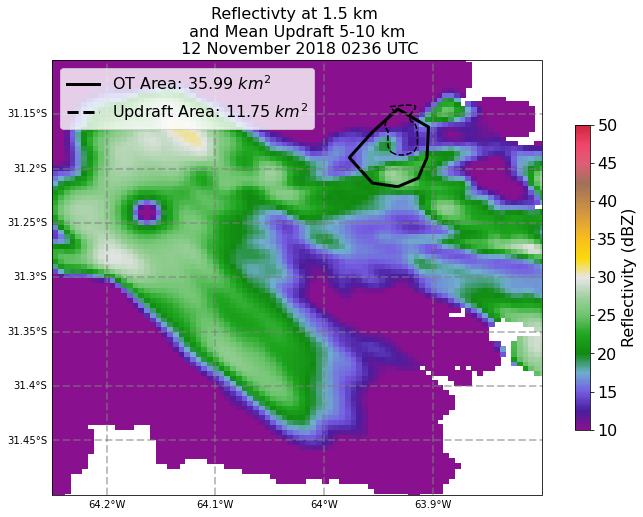
#ds = xr.open_dataset('dual_output/Nov12/man_edited_Nov12_0234.nc').squeeze()
ds = xr.open_dataset('dual_output/Nov12/new_cleaning/Nov12_0230.nc').squeeze()
#df_sub = geo_df[df.minute == 34]
lat_min = -31.3
lat_max = -31.1
lon_min = -64
lon_max = -63.9
lats = ds.lat.values
lons = ds.lon.values
w_vals = ds.where((ds.w > 0) & (ds.lat > lat_min) & (ds.lat < lat_max) & (ds.lon > lon_min) & (ds.lon < lon_max)).sel(z=slice(5000, 10000)).w
w = ds.where((ds.w > 0) & (ds.lat > lat_min) & (ds.lat < lat_max) & (ds.lon > lon_min) & (ds.lon < lon_max)).sel(z=slice(5000, 10000)).w.mean(dim='z').values
w_max = ds.where((ds.w > 0) & (ds.lat > lat_min) & (ds.lat < lat_max) & (ds.lon > lon_min) & (ds.lon < lon_max)).sel(z=slice(5000, 10000)).w.max(dim=['x','y'])
ref = ds.sel(z=3000).ZM_composite.values
area = len(w[np.where(w > 4)]) * .25
areas3, levels = calc_updraft_area(w_vals, 6)
wmax3 = w_max
/Users/mgrover/miniconda3/envs/unidata/lib/python3.7/site-packages/ipykernel_launcher.py:14: RuntimeWarning: invalid value encountered in greater
/Users/mgrover/miniconda3/envs/unidata/lib/python3.7/site-packages/ipykernel_launcher.py:15: RuntimeWarning: invalid value encountered in greater
from ipykernel import kernelapp as app
np.nanpercentile(w, 70)
2.537108953669664
fig = plt.figure(figsize=(12,8))
ax = plt.subplot(111, projection=ccrs.PlateCarree())
cf = plt.contourf(lons, lats,ref , np.arange(-20, 60, 4), cmap='pyart_HomeyerRainbow')
cb1 = plt.colorbar(cf, shrink=.7)
cb1.set_label('Reflectivity (dBZ)', fontsize=16)
cb1.ax.tick_params(labelsize=16)
#q = ax.quiver(lons[::2], lats[::2], u_wnd[::2], v_wnd[::2], pivot='mid', color='black', scale=50, scale_units='inches')
#ax.quiverkey(q, X=.95, Y=.1, U=10, label='10 m/s', labelpos='W')
w_mask = np.nan_to_num(w)
cf = plt.contour(lons, lats, w_mask , levels=[2,4, 30], colors=['black'], linestyles='dashed')
#plt.colorbar(cf, label='Vertical Velocity (m/s)', shrink=.7)
ot_df.plot(ax=ax, facecolor="none",
edgecolor='black',linewidth=3, label='otarea')
gl = ax.gridlines(crs=ccrs.PlateCarree(), draw_labels=True,
linewidth=2, color='gray', alpha=0.5, linestyle='--')
gl.top_labels = False
gl.left_labels= True
gl.right_labels = False
ax.set_extent((-64.25, -63.65, -31.5, -31.))
#plt.plot(0,0, color='black', label=f'OT Area: {ota[0].round(2)} $km^{2}$ ', linewidth=3)
plt.plot(0,0, color='black', label=f'Updraft Area: {area} $km^{2}$', linewidth=3, linestyle='--')
plt.legend(loc='upper left', fontsize=16)
plt.title('Reflectivity at 1.5 km \n and Mean Updraft 5-10 km \n 12 November 2018 0226 UTC', fontsize=18)
Text(0.5, 1.0, 'Reflectivity at 1.5 km \n and Mean Updraft 5-10 km \n 12 November 2018 0226 UTC')
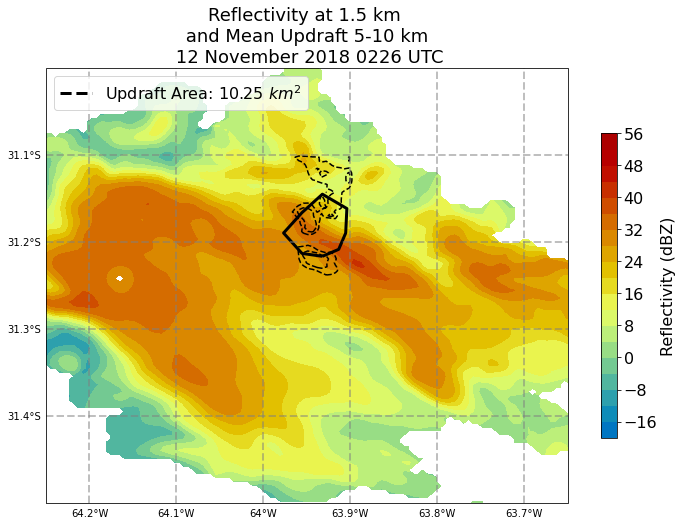
plt.plot(areas3, levels)
[<matplotlib.lines.Line2D at 0x7fb8eb350cd0>]
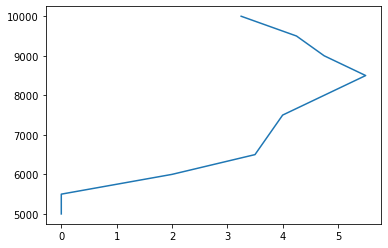
plt.plot(wmax3, levels)
[<matplotlib.lines.Line2D at 0x7fb8eb3e9990>]
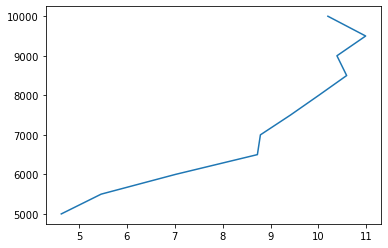
ds = xr.open_dataset('dual_output/Nov12/Nov12_0240.nc').squeeze()
df_sub = geo_df[df.minute == 41]
ot_df = df_sub[df_sub.lat == df_sub.lat.values[0]]
/Users/mgrover/miniconda3/envs/unidata/lib/python3.7/site-packages/geopandas/geodataframe.py:828: UserWarning: Boolean Series key will be reindexed to match DataFrame index.
result = super(GeoDataFrame, self).__getitem__(key)
---------------------------------------------------------------------------
IndexError Traceback (most recent call last)
<ipython-input-65-c26701b878ed> in <module>
3 df_sub = geo_df[df.minute == 41]
4
----> 5 ot_df = df_sub[df_sub.lat == df_sub.lat.values[0]]
IndexError: index 0 is out of bounds for axis 0 with size 0
ota = ot_df.area_circle_polygon.values
ot_lon = df_sub.lon.values[0]
ot_lat = df_sub.lat.values[0]
shift_x = ot_df.lon_corr.values[0] - ot_lon
shift_y = ot_df.lat_corr.values[0] - ot_lat
ot_df = ot_df.translate(shift_x, shift_y)
---------------------------------------------------------------------------
AttributeError Traceback (most recent call last)
<ipython-input-162-b52f368987db> in <module>
----> 1 ota = ot_df.area_circle_polygon.values
2
3 ot_lon = df_sub.lon.values[0]
4 ot_lat = df_sub.lat.values[0]
5
~/miniconda3/envs/unidata/lib/python3.7/site-packages/pandas/core/generic.py in __getattr__(self, name)
5128 if self._info_axis._can_hold_identifiers_and_holds_name(name):
5129 return self[name]
-> 5130 return object.__getattribute__(self, name)
5131
5132 def __setattr__(self, name: str, value) -> None:
AttributeError: 'GeoSeries' object has no attribute 'area_circle_polygon'
lats = ds.lat.values
lons = ds.lon.values
# (ds.lat > -31.2) & (ds.lat < -31.13) & (ds.lon > -64.1) & (ds.lon < -63.95)
w = ds.where((ds.w > 0)).sel(z=slice(6000, 10000)).w.mean(dim='z').values
ref = ds.sel(z=1500).ZM_composite.values
ua = len(w[np.where(w > 2)]) * .25
/Users/mgrover/miniconda3/envs/unidata/lib/python3.7/site-packages/xarray/core/nanops.py:142: RuntimeWarning: Mean of empty slice
return np.nanmean(a, axis=axis, dtype=dtype)
/Users/mgrover/miniconda3/envs/unidata/lib/python3.7/site-packages/ipykernel_launcher.py:9: RuntimeWarning: invalid value encountered in greater
if __name__ == '__main__':
fig = plt.figure(figsize=(12,8))
ax = plt.subplot(111, projection=ccrs.PlateCarree())
cf = plt.contourf(lons, lats,ref , np.arange(-20, 60, 4), cmap='pyart_HomeyerRainbow')
plt.colorbar(cf, label='Reflectivity (dBZ)', shrink=.7)
cf = plt.contourf(lons, lats,w , np.arange(2, 10, 0.5), cmap='magma')
plt.colorbar(cf, label='Vertical Velocity (m/s)', shrink=.7)
ot_df.plot(ax=ax, facecolor="none",
edgecolor='black',linewidth=3, label='otarea')
gl = ax.gridlines(crs=ccrs.PlateCarree(), draw_labels=True,
linewidth=2, color='gray', alpha=0.5, linestyle='--')
gl.top_labels = False
gl.left_labels= True
gl.right_labels = False
ax.set_extent((-64.25, -63.8, -31.5, -31.1))
plt.plot(0,0, color='black', label=f'OT Area: {ota[0].round(2)} $km^{2}$ \n Updraft Area: {ua} $km^{2}$', linewidth=3)
plt.legend(loc='upper right')
plt.title('Reflectivty at 1.5 km \n and Mean Updraft 5-10 km \n 12 November 2018 0242 UTC', fontsize=16)
#plt.savefig('summary_figs/Nov_12_2018_2034.png', dpi=400)
Text(0.5, 1.0, 'Reflectivty at 1.5 km \n and Mean Updraft 5-10 km \n 12 November 2018 0242 UTC')
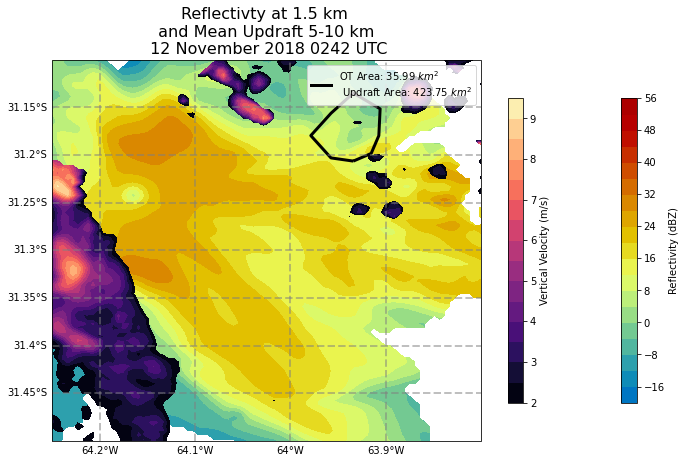
10 November 2018 Case¶
def plot_ot(ot_df_path, dda_ds_path, minute, minlat, maxlat, minlon, maxlon, time='2012', ot_index_val=0,):
# Read in the dataframe
df = pd.read_csv(ot_df_path, index_col='time', parse_dates=True)
# Read in DDA dataset
ds = xr.open_dataset(dda_ds_path).squeeze()
# Assign minutes
df['minute'] = df.index.minute
# Convert geometry
df['geometry'] = df['geometry'].apply(wkt.loads)
geo_df = gpd.GeoDataFrame(df, geometry='geometry')
# Subset minute
df_sub = geo_df[df.minute == minute]
# Read in index val
ot_df = df_sub[df_sub.lat == df_sub.lat.values[ot_index_val]]
# Extract OTA
ota = ot_df.area_circle_polygon.values
# Extract Centroid location
ot_lon = ot_df.centroid.x.values[0]
ot_lat = ot_df.centroid.y.values[0]
# Shift over OT
shift_x = ot_df.lon.values[0] - ot_lon
shift_y = ot_df.lat.values[0] - ot_lat
ot_df = ot_df.translate(shift_x, shift_y)
# Extract lat and lon values
lats = ds.lat.values
lons = ds.lon.values
# Extract updraft velocities
ds_w = ds.where((ds.w > 0) & (ds.lat > minlat) & (ds.lat < maxlon) & (ds.lon > minlon) & (ds.lon < maxlon)).sel(z=slice(3000, 10000)).w.mean(dim='z').values
ref = ds.sel(z=1500).ZM_composite.values
w = ds_w
count = len(w[np.where(w > 8)])
updraft_area = count * .25
fig = plt.figure(figsize=(12,8))
ax = plt.subplot(111, projection=ccrs.PlateCarree())
cf = plt.contourf(lons, lats,ref , np.arange(-20, 60, 4), cmap='pyart_HomeyerRainbow')
plt.colorbar(cf, label='Reflectivity (dBZ)', shrink=.7)
cf = plt.contourf(lons, lats, w , np.arange(8, 20, 0.5), cmap='magma')
plt.colorbar(cf, label='Vertical Velocity (m/s)', shrink=.7)
ot_df.plot(ax=ax, facecolor="none",
edgecolor='red',linewidth=3, label='otarea')
gl = ax.gridlines(crs=ccrs.PlateCarree(), draw_labels=True,
linewidth=2, color='gray', alpha=0.5, linestyle='--')
gl.top_labels = False
gl.left_labels= True
gl.right_labels = False
ax.set_extent((-64.3, -63.9, -32.2, -31.9))
plt.plot(0,0, color='red', label=f'OT Area: {ota[0].round(2)} km2 \n Updraft Area: 11 km2', linewidth=3)
plt.legend(loc='upper right')
plt.title('Reflectivty at 1.5 km \n and Mean Updraft 3-10 km \n 10 November 2018 2012 UTC', fontsize=16)
plt.savefig('summary_figs/Nov_10_2018_2012.png', dpi=400)
df = pd.read_csv('ot_output/Revised_OTs_10_Nov_2007_2024.csv', index_col='time', parse_dates=True)
df['mean_rad'] = np.mean(df[['e_radial', 'se_radial', 's_radial', 'sw_radial', 'w_radial', 'nw_radial', 'n_radial', 'ne_radial']].values * 2, 1)
df['ot_depth'] = df.cloudtop_height - df.tropopause_height
from datetime import datetime
df.ot_depth.plot(color='black')
#df.mintb.plot(color='blue')
plt.axvline(datetime(2018, 11, 10, 20, 15))
<matplotlib.lines.Line2D at 0x7fdaf69b15d0>
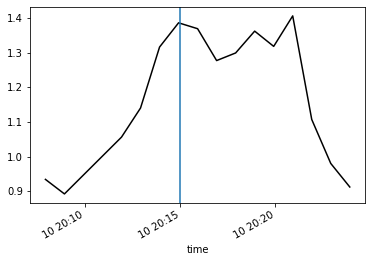
df['ot_depth'] = df.cloudtop_height - df.tropopause_height
df[['area_circle_polygon', 'ot_depth', 'mintb']]
| area_circle_polygon | ot_depth | mintb | |
|---|---|---|---|
| time | |||
| 2018-11-10 20:07:55.000000512 | 76.837805 | 0.934000 | 195.819992 |
| 2018-11-10 20:08:55.000000512 | 108.972626 | 0.892000 | 196.080002 |
| 2018-11-10 20:11:55.000000512 | 111.806680 | 1.056000 | 195.089996 |
| 2018-11-10 20:12:55.000000512 | 110.269330 | 1.139999 | 194.509995 |
| 2018-11-10 20:13:55.000000512 | 121.941273 | 1.316000 | 193.399994 |
| 2018-11-10 20:14:55.000000512 | 108.745111 | 1.386000 | 192.889999 |
| 2018-11-10 20:15:55.000000512 | 95.532540 | 1.369001 | 192.989990 |
| 2018-11-10 20:16:55.000000512 | 86.517142 | 1.277000 | 193.610001 |
| 2018-11-10 20:17:55.000000512 | 68.686139 | 1.299000 | 193.470001 |
| 2018-11-10 20:18:55.000000512 | 55.039897 | 1.362000 | 193.000000 |
| 2018-11-10 20:19:55.000000512 | 50.192336 | 1.318001 | 193.339996 |
| 2018-11-10 20:20:55.000000512 | 39.628697 | 1.406000 | 192.720001 |
| 2018-11-10 20:21:55.000000512 | 42.935395 | 1.107000 | 194.639999 |
| 2018-11-10 20:22:55.000000512 | 36.549424 | 0.980001 | 195.449997 |
| 2018-11-10 20:23:55.000000512 | 35.895178 | 0.912001 | 195.849991 |
ds = xr.open_dataset('dual_output/Nov10/2014.nc').squeeze()
df['minute'] = df.index.minute + 1
from shapely import wkt
df['geometry'] = df['geometry'].apply(wkt.loads)
geo_df = gpd.GeoDataFrame(df, geometry='geometry')
df_sub = geo_df[df.minute == 13]
ot_df = df_sub[df_sub.lat == df_sub.lat.values[0]]
ota = ot_df.area_circle_polygon.values
ot_lon = ot_df.centroid.x.values[0]
ot_lat = ot_df.centroid.y.values[0]
shift_x = ot_df.lon_corr.values[0] - ot_lon
shift_y = ot_df.lat_corr.values[0] - ot_lat
ot_df = ot_df.translate(shift_x, shift_y)
lats = ds.lat.values
lons = ds.lon.values
w_vals = ds.where((ds.w > 0) & (ds.lat < -31.94) & (ds.lat > -32.05) & (ds.lon < -64.1)).sel(z=slice(3000, 12000)).w
ds_w = ds.where((ds.w > 0) & (ds.lat < -31.94) & (ds.lat > -32.05) & (ds.lon < -64.1)).sel(z=slice(5000, 10000)).w.mean(dim='z').values
ds_wmax = ds.where((ds.w > 0) & (ds.lat < -31.94) & (ds.lat > -32.05) & (ds.lon < -64.1)).sel(z=slice(3000, 12000)).w.max(dim=['x', 'y'])
ref = ds.sel(z=1500).ZM_composite.values
w_max_list = []
w_max_list.append(ds_wmax)
w_area_list = []
areas, levels = calc_updraft_area(w_vals, 4)
w_area_list.append(xr.DataArray(areas, coords={'z':levels,
'time':ds_wmax.time}, dims={'z':levels}))
/Users/mgrover/miniconda3/envs/unidata/lib/python3.7/site-packages/ipykernel_launcher.py:15: RuntimeWarning: invalid value encountered in greater
from ipykernel import kernelapp as app
w = ds_w
np.nanmax(ds_wmax)
24.65440187145197
count = len(w[np.where(w > 4)]) * .25
w_mean = np.nanmean(w[np.where(w > 4)])
/Users/mgrover/miniconda3/envs/unidata/lib/python3.7/site-packages/ipykernel_launcher.py:1: RuntimeWarning: invalid value encountered in greater
"""Entry point for launching an IPython kernel.
/Users/mgrover/miniconda3/envs/unidata/lib/python3.7/site-packages/ipykernel_launcher.py:2: RuntimeWarning: invalid value encountered in greater
w_mean
7.106634866081917
fig = plt.figure(figsize=(12,8))
ax = plt.subplot(111, projection=ccrs.PlateCarree())
cf = plt.pcolormesh(lons, lats,ref , vmin=10, vmax=50, cmap='pyart_Carbone17')
plt.colorbar(cf, label='Reflectivity (dBZ)', shrink=.7)
w_mask = np.nan_to_num(w)
cf = plt.contour(lons, lats, w_mask , levels=[4, 30], colors=['black'], linestyles='dashed')
#plt.colorbar(cf, label='Vertical Velocity (m/s)', shrink=.7)
ot_df.plot(ax=ax, facecolor="none",
edgecolor='black',linewidth=3, label='otarea')
gl = ax.gridlines(crs=ccrs.PlateCarree(), draw_labels=True,
linewidth=2, color='gray', alpha=0.5, linestyle='--')
gl.top_labels = False
gl.left_labels= True
gl.right_labels = False
ax.set_extent((-64.3, -63.9, -32.2, -31.9))
plt.plot(0,0, color='black', label=f'OT Area: {ota[0].round(2)} $km^{2}$ ', linewidth=3)
plt.plot(0,0, color='black', label=f'Updraft Area: {count} $km^{2}$', linewidth=3, linestyle='--')
plt.legend(loc='upper right', fontsize=14)
plt.title('Reflectivty at 1.5 km \n and Mean Updraft 5-10 km \n 10 November 2018 2014 UTC', fontsize=16)
plt.savefig('summary_figs/Nov_10_2018_2014.png', dpi=400)
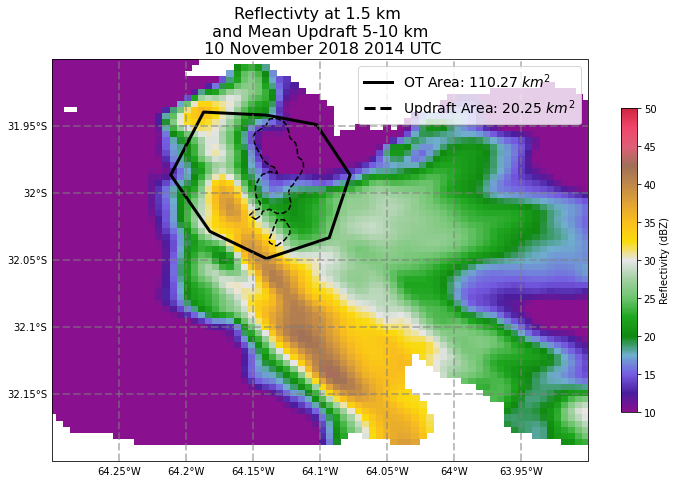
10 November 2018 2007 UTC¶
ds = xr.open_dataset('dual_output/Nov10/2007.nc').squeeze()
ot_df = geo_df[df.minute == 8]
ota = ot_df.area_circle_polygon.values
ot_lon = ot_df.centroid.x.values[0]
ot_lat = ot_df.centroid.y.values[0]
shift_x = ot_df.lon_corr.values[0] - ot_lon
shift_y = ot_df.lat_corr.values[0] - ot_lat
ot_df = ot_df.translate(shift_x, shift_y)
lats = ds.lat.values
lons = ds.lon.values
w_vals = ds.where((ds.w > 0) & ((ds.lon > -64.2) & (ds.lon < -64.1) & (ds.lat >-32.02)& (ds.lat < -31.95))).sel(z=slice(3000, 12000)).w
ds_w = ds.where((ds.w > 0) & ((ds.lon > -64.2) & (ds.lon < -64.1) & (ds.lat >-32.02)& (ds.lat < -31.95))).sel(z=slice(5000, 10000)).w.mean(dim='z').values
ds_wmax = ds.where((ds.w > 0) & (ds.lat > -32.05) & (ds.lon < -64.1)).sel(z=slice(3000, 12000)).w.max(dim=['x','y'])
w_max_list.append(ds_wmax)
areas, levels = calc_updraft_area(w_vals, 4)
w_area_list.append(xr.DataArray(areas, coords={'z':levels,
'time':ds_wmax.time}, dims={'z':levels}))
ref = ds.sel(z=1500).ZM_composite.values
print('Max Vel: ', np.nanmax(ds_wmax))
Max Vel: 20.043541295937167
/Users/mgrover/miniconda3/envs/unidata/lib/python3.7/site-packages/ipykernel_launcher.py:15: RuntimeWarning: invalid value encountered in greater
from ipykernel import kernelapp as app
ds_wmax.assign_attrs(updraft_area=[0, 1])
<xarray.DataArray 'w' (z: 19)>
array([ 7.44312289, 6.85908383, 6.86061985, 5.5285899 , 5.97692763,
5.67946986, 6.54481647, 9.12689833, 9.48607372, 10.27962929,
10.12974101, 11.82803872, 11.69841943, 12.78977562, 13.63978675,
18.3498372 , 20.0435413 , 16.32938832, 2.91017584])
Coordinates:
time datetime64[ns] 2018-11-10T20:06:19.075000
* z (z) float64 3e+03 3.5e+03 4e+03 ... 1.1e+04 1.15e+04 1.2e+04
Attributes:
updraft_area: [0, 1]xarray.DataArray
'w'
- z: 19
- 7.443 6.859 6.861 5.529 5.977 5.679 ... 13.64 18.35 20.04 16.33 2.91
array([ 7.44312289, 6.85908383, 6.86061985, 5.5285899 , 5.97692763, 5.67946986, 6.54481647, 9.12689833, 9.48607372, 10.27962929, 10.12974101, 11.82803872, 11.69841943, 12.78977562, 13.63978675, 18.3498372 , 20.0435413 , 16.32938832, 2.91017584]) - time()datetime64[ns]2018-11-10T20:06:19.075000
array('2018-11-10T20:06:19.075000000', dtype='datetime64[ns]') - z(z)float643e+03 3.5e+03 ... 1.15e+04 1.2e+04
- standard_name :
- projection_z_coordinate
- long_name :
- Z distance on the projection plane from the origin
- axis :
- Z
- units :
- m
- positive :
- up
array([ 3000., 3500., 4000., 4500., 5000., 5500., 6000., 6500., 7000., 7500., 8000., 8500., 9000., 9500., 10000., 10500., 11000., 11500., 12000.])
- updraft_area :
- [0, 1]
areas
array([ 2.5 , 1.75, 1.75, 0. , 0.75, 0.5 , 1. , 2. , 1.75,
3.5 , 5.5 , 11.25, 10. , 9. , 8.25, 6. , 3.5 , 1.25,
0. ])
w = ds_w
count = len(w[np.where(w > 4)]) * .25
w_mean = np.nanmean(w[np.where(w > 4)])
fig = plt.figure(figsize=(12,8))
ax = plt.subplot(111, projection=ccrs.PlateCarree())
cf = plt.pcolormesh(lons, lats,ref , vmin=10, vmax=50, cmap='pyart_Carbone17')
cb1 = plt.colorbar(cf, shrink=.7)
cb1.set_label('Reflectivity (dBZ)', fontsize=16)
cb1.ax.tick_params(labelsize=16)
#q = ax.quiver(lons[::2], lats[::2], u_wnd[::2], v_wnd[::2], pivot='mid', color='black', scale=50, scale_units='inches')
#ax.quiverkey(q, X=.95, Y=.1, U=10, label='10 m/s', labelpos='W')
w_mask = np.nan_to_num(w)
cf = plt.contour(lons, lats, w_mask , levels=[4, 40], colors=['black'], linestyles='dashed')
#cb = plt.colorbar(cf, shrink=.7)
#cb.set_label('Vertical Velocity (m/s)', fontsize=16)
cb1.ax.tick_params(labelsize=16)
ot_df.plot(ax=ax, facecolor="none",
edgecolor='black',linewidth=3, label='otarea')
gl = ax.gridlines(crs=ccrs.PlateCarree(), draw_labels=True,
linewidth=2, color='gray', alpha=0.5, linestyles='solid')
gl.top_labels = False
gl.left_labels= True
gl.right_labels = False
gl.xlabel_style = {'size': 16, 'color': 'k'}
gl.ylabel_style = {'size': 16, 'color': 'k'}
ax.set_extent((-64.3, -63.9, -32.2, -31.9))
plt.plot(0,0, color='black', label=f'OT Area: {ota[0].round(2)} $km^{2}$ ', linewidth=3)
plt.plot(0,0, color='black', label=f'Updraft Area: {count} $km^{2}$', linewidth=3, linestyle='--')
plt.legend(loc='upper right', fontsize=14)
plt.title('Reflectivity at 1.5 km \n and Mean Updraft 5-10 km \n 10 November 2018 2007 UTC', fontsize=16)
plt.savefig('summary_figs/Nov_10_2018_2007.png', dpi=400)
/Users/mgrover/miniconda3/envs/unidata/lib/python3.7/site-packages/ipykernel_launcher.py:2: RuntimeWarning: invalid value encountered in greater
/Users/mgrover/miniconda3/envs/unidata/lib/python3.7/site-packages/ipykernel_launcher.py:3: RuntimeWarning: invalid value encountered in greater
This is separate from the ipykernel package so we can avoid doing imports until
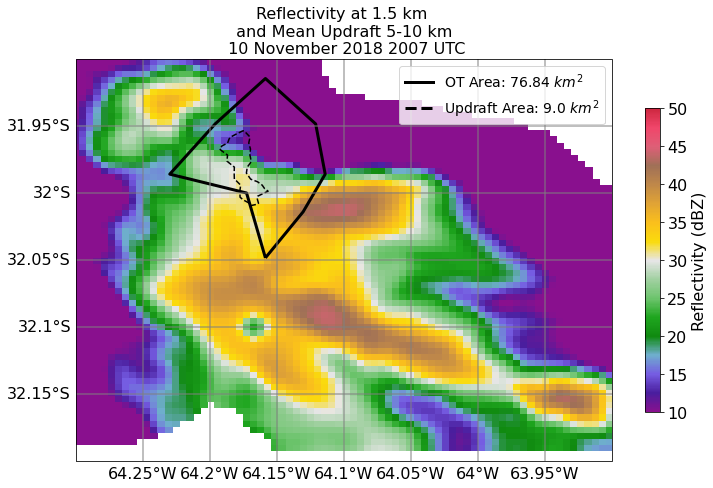
10 November 2018 2012 UTC¶
ds = xr.open_dataset('dual_output/Nov10/2012.nc').squeeze()
ot_df = geo_df[geo_df.minute == 12]
ot_df.area_circle_polygon.values[0]
111.80667965395409
df_sub = geo_df[df.minute == 12]
ot_df = df_sub[df_sub.lat == df_sub.lat.values[0]]
ota = ot_df.area_circle_polygon.values
ot_lon = ot_df.centroid.x.values[0]
ot_lat = ot_df.centroid.y.values[0]
shift_x = ot_df.lon_corr.values[0] - ot_lon
shift_y = ot_df.lat_corr.values[0] - ot_lat
ot_df = ot_df.translate(shift_x, shift_y)
fig = plt.figure(figsize=(12,8))
ax = plt.subplot(111, projection=ccrs.PlateCarree())
ds_w = ds.where((ds.w > 0) & (ds.lon < -64.1) & (ds.lat >-32.03)).sel(z=slice(5000, 10000)).w.mean(dim='z').values
w = ds.sel(z=6000).w.values
lons = ds.lon.values
lats = ds.lat.values
lons, lats = np.meshgrid(lons, lats)
#c = plt.contour(lons, lats, w, levels=np.arange(4, 26,20), cmap='seismic')
cf = plt.contourf(lons, lats, w, levels=np.arange(-24, 26,2), cmap='seismic')
cb1 = plt.colorbar(cf, shrink=.9)
cb1.set_label('Vertical Velocity ($ms^{-1}$)', fontsize=16)
cb1.ax.tick_params(labelsize=16)
#q = ax.quiver(lons[::2], lats[::2], u_wnd[::2], v_wnd[::2], pivot='mid', color='black', scale=50, scale_units='inches')
#ax.quiverkey(q, X=.95, Y=.1, U=10, label='10 m/s', labelpos='W')
ot_df.plot(ax=ax, facecolor="none",
edgecolor='black',linewidth=3, label='otarea')
gl = ax.gridlines(crs=ccrs.PlateCarree(), draw_labels=True,
linewidth=2, color='gray', alpha=0.5, linestyles='solid')
gl.top_labels = False
gl.left_labels= True
gl.right_labels = False
gl.xlabel_style = {'size': 16, 'color': 'k'}
gl.ylabel_style = {'size': 16, 'color': 'k'}
ax.set_extent((-64.3, -63.9, -32.2, -31.9))
#plt.plot(0,0, color='black', label=f'OT Area: {ota[0].round(2)} $km^{2}$ ', linewidth=3)
#plt.legend(loc='upper right', fontsize=14)
plt.title('Vertical Velocity at 6 km and OT \n 10 November 2018 2012 UTC', fontsize=16)
plt.savefig('summary_figs/Nov_10_2018_2012_w.png', dpi=400)
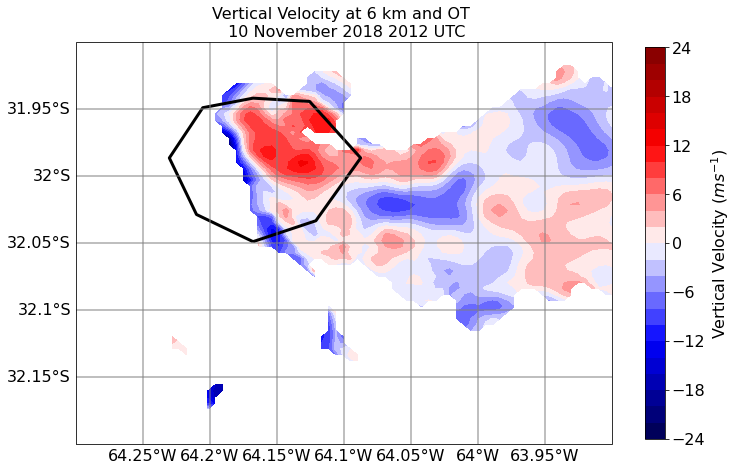
ds.sel(z=6000).w.plot.contourf(x='lon', y='lat', levels=np.arange(-24, 24, 2))
---------------------------------------------------------------------------
ValueError Traceback (most recent call last)
<ipython-input-44-d73908664689> in <module>
----> 1 ds.sel(z=6000).w.plot.contourf(x='lon', y='lat', levels=np.arange(-24, 24, 2))
~/miniconda3/envs/unidata/lib/python3.7/site-packages/xarray/plot/plot.py in plotmethod(_PlotMethods_obj, x, y, figsize, size, aspect, ax, row, col, col_wrap, xincrease, yincrease, add_colorbar, add_labels, vmin, vmax, cmap, colors, center, robust, extend, levels, infer_intervals, subplot_kws, cbar_ax, cbar_kwargs, xscale, yscale, xticks, yticks, xlim, ylim, norm, **kwargs)
842 for arg in ["_PlotMethods_obj", "newplotfunc", "kwargs"]:
843 del allargs[arg]
--> 844 return newplotfunc(**allargs)
845
846 # Add to class _PlotMethods
~/miniconda3/envs/unidata/lib/python3.7/site-packages/xarray/plot/plot.py in newplotfunc(darray, x, y, figsize, size, aspect, ax, row, col, col_wrap, xincrease, yincrease, add_colorbar, add_labels, vmin, vmax, cmap, center, robust, extend, levels, infer_intervals, colors, subplot_kws, cbar_ax, cbar_kwargs, xscale, yscale, xticks, yticks, xlim, ylim, norm, **kwargs)
669
670 xlab, ylab = _infer_xy_labels(
--> 671 darray=darray, x=x, y=y, imshow=imshow_rgb, rgb=rgb
672 )
673
~/miniconda3/envs/unidata/lib/python3.7/site-packages/xarray/plot/utils.py in _infer_xy_labels(darray, x, y, imshow, rgb)
384 y = darray.dims[0] if x == darray.dims[1] else darray.dims[1]
385 else:
--> 386 _assert_valid_xy(darray, x, "x")
387 _assert_valid_xy(darray, y, "y")
388
~/miniconda3/envs/unidata/lib/python3.7/site-packages/xarray/plot/utils.py in _assert_valid_xy(darray, xy, name)
410 if xy not in valid_xy:
411 valid_xy_str = "', '".join(sorted(valid_xy))
--> 412 raise ValueError(f"{name} must be one of None, '{valid_xy_str}'")
413
414
ValueError: x must be one of None, 'time', 'x', 'y', 'z'
ot_df = geo_df[df.minute == 12]
ota = ot_df.area_circle_polygon.values
ot_lon = ot_df.centroid.x.values[0]
ot_lat = ot_df.centroid.y.values[0]
shift_x = ot_df.lon_corr.values[0] - ot_lon
shift_y = ot_df.lat_corr.values[0] - ot_lat
ot_df = ot_df.translate(shift_x, shift_y)
lats = ds.lat.values
lons = ds.lon.values
w_vals = ds.where((ds.w > 0) & (ds.lon < -64.1) & (ds.lat >-32.03)).sel(z=slice(3000, 12000)).w
ds_w = ds.where((ds.w > 0) & (ds.lon < -64.1) & (ds.lat >-32.03)).sel(z=slice(5000, 10000)).w.mean(dim='z').values
ds_wmax = ds.where((ds.w > 0) & (ds.lat > -32.05) & (ds.lon < -64.1)).sel(z=slice(3000, 12000)).w.max(dim=['x','y'])
ref = ds.sel(z=1500).ZM_composite.values
w_max_list.append(ds_wmax)
areas, levels = calc_updraft_area(w_vals, 4)
w_area_list.append(xr.DataArray(areas, coords={'z':levels,
'time':ds_wmax.time}, dims={'z':levels}))
np.nanmax(ds_wmax)
/Users/mgrover/miniconda3/envs/unidata/lib/python3.7/site-packages/ipykernel_launcher.py:15: RuntimeWarning: invalid value encountered in greater
from ipykernel import kernelapp as app
25.525771181621675
w = ds_w
count = len(w[np.where(w > 4)]) * .25
w_mean = np.nanmean(w[np.where(w > 4)])
/Users/mgrover/miniconda3/envs/unidata/lib/python3.7/site-packages/ipykernel_launcher.py:1: RuntimeWarning: invalid value encountered in greater
"""Entry point for launching an IPython kernel.
/Users/mgrover/miniconda3/envs/unidata/lib/python3.7/site-packages/ipykernel_launcher.py:2: RuntimeWarning: invalid value encountered in greater
ota
array([111.80667965])
fig = plt.figure(figsize=(12,8))
ax = plt.subplot(111, projection=ccrs.PlateCarree())
cf = plt.pcolormesh(lons, lats,ref , vmin=10, vmax=50, cmap='pyart_Carbone17')
cb1 = plt.colorbar(cf, shrink=.7)
cb1.set_label('Reflectivity (dBZ)', fontsize=16)
cb1.ax.tick_params(labelsize=16)
#q = ax.quiver(lons[::2], lats[::2], u_wnd[::2], v_wnd[::2], pivot='mid', color='black', scale=50, scale_units='inches')
#ax.quiverkey(q, X=.95, Y=.1, U=10, label='10 m/s', labelpos='W')
w_mask = np.nan_to_num(w)
cf = plt.contour(lons, lats, w_mask , levels=[4,40], colors=['black'], linestyles='dashed')
#cb = plt.colorbar(cf, shrink=.7)
#cb.set_label('Vertical Velocity (m/s)', fontsize=16)
cb1.ax.tick_params(labelsize=16)
ot_df.plot(ax=ax, facecolor="none",
edgecolor='black',linewidth=3, label='otarea')
gl = ax.gridlines(crs=ccrs.PlateCarree(), draw_labels=True,
linewidth=2, color='gray', alpha=0.5, linestyles='solid')
gl.top_labels = False
gl.left_labels= True
gl.right_labels = False
gl.xlabel_style = {'size': 16, 'color': 'k'}
gl.ylabel_style = {'size': 16, 'color': 'k'}
ax.set_extent((-64.3, -63.9, -32.2, -31.9))
plt.plot(0,0, color='black', label=f'OT Area: {ota[0].round(2)} $km^{2}$ ', linewidth=3)
plt.plot(0,0, color='black', label=f'Updraft Area: {count} $km^{2}$', linewidth=3, linestyle='--')
plt.legend(loc='upper right', fontsize=14)
plt.title('Reflectivity at 1.5 km \n and Mean Updraft 5-10 km \n 10 November 2018 2012 UTC', fontsize=16)
plt.savefig('summary_figs/Nov_10_2018_2012.png', dpi=400)
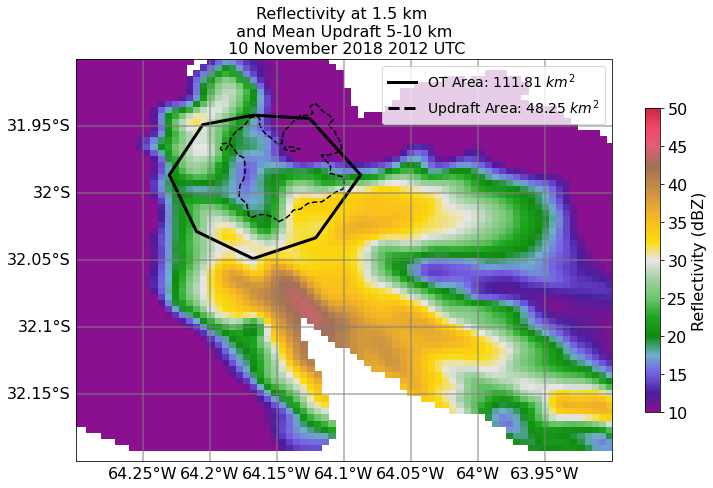
ds_w = ds.where((ds.w > 4) & (ds.lon < -64.1)).sel(z=6000).w.values
w = ds_w[np.where(ds_w > 8)]
rho = .4
a = len(w) * 500 * 500
mass_f = rho * w
/Users/mgrover/miniconda3/envs/unidata/lib/python3.7/site-packages/ipykernel_launcher.py:1: RuntimeWarning: invalid value encountered in greater
"""Entry point for launching an IPython kernel.
len(w) * .25
18.25
np.sum(w) * len(w)* (.25)
13127.455826883453
(np.sum(mass_f) * a)/1e2
52509823.307533816
10 November 2018 2020 UTC¶
ds = xr.open_dataset('dual_output/Nov10/2021.nc').squeeze()
ot_df = geo_df[df.minute == 21]
ota = ot_df.area_circle_polygon.values
ot_lon = ot_df.centroid.x.values[0]
ot_lat = ot_df.centroid.y.values[0]
shift_x = ot_df.lon_corr.values[0] - ot_lon
shift_y = ot_df.lat_corr.values[0] - ot_lat
ot_df = ot_df.translate(shift_x, shift_y)
lats = ds.lat.values
lons = ds.lon.values
w_vals = ds.where((ds.w > 0)& (ds.lat > -32.01) & (ds.lat < -31.95) & (ds.lon > -64.075) & (ds.lon < -64.02)).sel(z=slice(3000, 12000)).w
ds_w = ds.where((ds.w > 0)& (ds.lat > -32.01) & (ds.lat < -31.95) & (ds.lon > -64.075) & (ds.lon < -64.02)).sel(z=slice(3000, 10000)).w.mean(dim='z').values
ds_wmax = ds.where((ds.w > 0) & (ds.lat > -32.05) & (ds.lon < -64.1)).sel(z=slice(3000, 12000)).w.max(dim=['x','y'])
ref = ds.sel(z=1500).ZM_composite.values
w_max_list.append(ds_wmax)
areas, levels = calc_updraft_area(w_vals, 4)
w_area_list.append(xr.DataArray(areas, coords={'z':levels,
'time':ds_wmax.time}, dims={'z':levels}))
np.nanmax(ds_wmax)
/Users/mgrover/miniconda3/envs/unidata/lib/python3.7/site-packages/ipykernel_launcher.py:15: RuntimeWarning: invalid value encountered in greater
from ipykernel import kernelapp as app
21.391447884993497
ot_df
time
2018-11-10 20:20:55.000000512 POLYGON ((-64.05492 -32.03372, -64.03147 -32.0...
dtype: geometry
w = ds_w
count = len(w[np.where(w > 4)]) * .25
w_mean = np.mean(w[np.where(w > 4)])
/Users/mgrover/miniconda3/envs/unidata/lib/python3.7/site-packages/ipykernel_launcher.py:1: RuntimeWarning: invalid value encountered in greater
"""Entry point for launching an IPython kernel.
/Users/mgrover/miniconda3/envs/unidata/lib/python3.7/site-packages/ipykernel_launcher.py:2: RuntimeWarning: invalid value encountered in greater
print(w_mean)
7.4361382325885055
fig = plt.figure(figsize=(12,8))
ax = plt.subplot(111, projection=ccrs.PlateCarree())
cf = plt.pcolormesh(lons, lats,ref , vmin=10, vmax=50, cmap='pyart_Carbone17')
cb1 = plt.colorbar(cf, shrink=.7)
cb1.set_label('Reflectivity (dBZ)', fontsize=16)
cb1.ax.tick_params(labelsize=16)
#q = ax.quiver(lons[::2], lats[::2], u_wnd[::2], v_wnd[::2], pivot='mid', color='black', scale=50, scale_units='inches')
#ax.quiverkey(q, X=.95, Y=.1, U=10, label='10 m/s', labelpos='W')
w_mask = np.nan_to_num(w)
cf = plt.contour(lons, lats, w_mask , levels=[4, 30], colors=['black'], linestyles='--', linewidth=3)
#cb = plt.colorbar(cf, shrink=.7)
#cb.set_label('Vertical Velocity (m/s)', fontsize=16)
cb1.ax.tick_params(labelsize=16)
ot_df.plot(ax=ax, facecolor="none",
edgecolor='black',linewidth=3, label='otarea')
gl = ax.gridlines(crs=ccrs.PlateCarree(), draw_labels=True,
linewidth=2, color='gray', alpha=0.5, linestyle='--')
gl.top_labels = False
gl.left_labels= True
gl.right_labels = False
gl.xlabel_style = {'size': 16, 'color': 'k'}
gl.ylabel_style = {'size': 16, 'color': 'k'}
ax.set_extent((-64.3, -63.9, -32.2, -31.9))
plt.plot(0,0, color='black', label=f'OT Area: {ota[0].round(2)} $km^{2}$ ', linewidth=3)
plt.plot(0,0, color='black', label=f'Updraft Area: {count} $km^{2}$', linewidth=3, linestyle='--')
plt.legend(loc='upper left', fontsize=14)
plt.title('Reflectivty at 1.5 km \n and Mean Updraft 5-10 km \n 10 November 2018 2021 UTC', fontsize=16)
plt.savefig('summary_figs/Nov_10_2018_2020.png', dpi=400)
/Users/mgrover/miniconda3/envs/unidata/lib/python3.7/site-packages/cartopy/mpl/geoaxes.py:1478: UserWarning: The following kwargs were not used by contour: 'linewidth'
result = matplotlib.axes.Axes.contour(self, *args, **kwargs)

ds_wmax = xr.concat(w_max_list, 'time')
ds_warea = xr.concat(w_area_list, 'time')
ds_wmax = ds_wmax.sortby('time')
ds_warea = ds_warea.sortby('time')
fig = plt.figure(figsize=(20,8))
colors = ['tab:blue', 'tab:orange', 'tab:green', 'tab:red']
for time in range(len(ds_wmax.time)):
ds_w = ds_wmax.isel(time=time)
ds_wa = ds_warea.isel(time=time)
mean_w = np.nanmean(ds_w)
max_w = np.nanmax(ds_w)
timestamp = int(pd.to_datetime(ds_w.time.values).strftime('%H%M'))
ax = plt.subplot(121)
ax.plot(ds_w.values, ds_w.z, label=f'{timestamp} UTC', color=colors[time])
wmax = '$w_{max}$'
#ax.axvline(mean_w, label=f'Mean {wmax} in 5-10 km layer {np.round(mean_w, 2)} m/s', linestyle=':', color=colors[time])
#ax.axvline(max_w, label=f'Max {wmax} in 5-10 km layer {np.round(max_w, 2)} m/s', linestyle='--', color=colors[time])
plt.title('$w_{max}$ Vertical Profiles')
plt.xticks(fontsize=12)
plt.yticks(fontsize=12)
plt.xlabel('$W_{max}$ (m/s)', fontsize=16)
plt.ylabel('Height (km)', fontsize=16)
plt.legend(loc='upper left', fontsize=12)
ax2 = plt.subplot(122)
ax2.plot(ds_wa.values, ds_wa.z, label=f'{timestamp} UTC', color=colors[time])
plt.title('$w_{area}$ Vertical Profiles', fontsize=16)
plt.xticks(fontsize=12)
plt.yticks(fontsize=12)
plt.xlabel('$W_{area}$ ($km^2$)', fontsize=16)
plt.ylabel('Height (km)', fontsize=16)
plt.legend(loc='upper left', fontsize=12)
plt.suptitle('10 November 2018 Updraft Vertical Profiles', fontsize=24)
plt.savefig('Vertical_w_prof_10_nov.png', dpi=400)
/Users/mgrover/miniconda3/envs/unidata/lib/python3.7/site-packages/ipykernel_launcher.py:12: MatplotlibDeprecationWarning: Adding an axes using the same arguments as a previous axes currently reuses the earlier instance. In a future version, a new instance will always be created and returned. Meanwhile, this warning can be suppressed, and the future behavior ensured, by passing a unique label to each axes instance.
if sys.path[0] == '':
/Users/mgrover/miniconda3/envs/unidata/lib/python3.7/site-packages/ipykernel_launcher.py:26: MatplotlibDeprecationWarning: Adding an axes using the same arguments as a previous axes currently reuses the earlier instance. In a future version, a new instance will always be created and returned. Meanwhile, this warning can be suppressed, and the future behavior ensured, by passing a unique label to each axes instance.
/Users/mgrover/miniconda3/envs/unidata/lib/python3.7/site-packages/ipykernel_launcher.py:12: MatplotlibDeprecationWarning: Adding an axes using the same arguments as a previous axes currently reuses the earlier instance. In a future version, a new instance will always be created and returned. Meanwhile, this warning can be suppressed, and the future behavior ensured, by passing a unique label to each axes instance.
if sys.path[0] == '':
/Users/mgrover/miniconda3/envs/unidata/lib/python3.7/site-packages/ipykernel_launcher.py:26: MatplotlibDeprecationWarning: Adding an axes using the same arguments as a previous axes currently reuses the earlier instance. In a future version, a new instance will always be created and returned. Meanwhile, this warning can be suppressed, and the future behavior ensured, by passing a unique label to each axes instance.
/Users/mgrover/miniconda3/envs/unidata/lib/python3.7/site-packages/ipykernel_launcher.py:12: MatplotlibDeprecationWarning: Adding an axes using the same arguments as a previous axes currently reuses the earlier instance. In a future version, a new instance will always be created and returned. Meanwhile, this warning can be suppressed, and the future behavior ensured, by passing a unique label to each axes instance.
if sys.path[0] == '':
/Users/mgrover/miniconda3/envs/unidata/lib/python3.7/site-packages/ipykernel_launcher.py:26: MatplotlibDeprecationWarning: Adding an axes using the same arguments as a previous axes currently reuses the earlier instance. In a future version, a new instance will always be created and returned. Meanwhile, this warning can be suppressed, and the future behavior ensured, by passing a unique label to each axes instance.
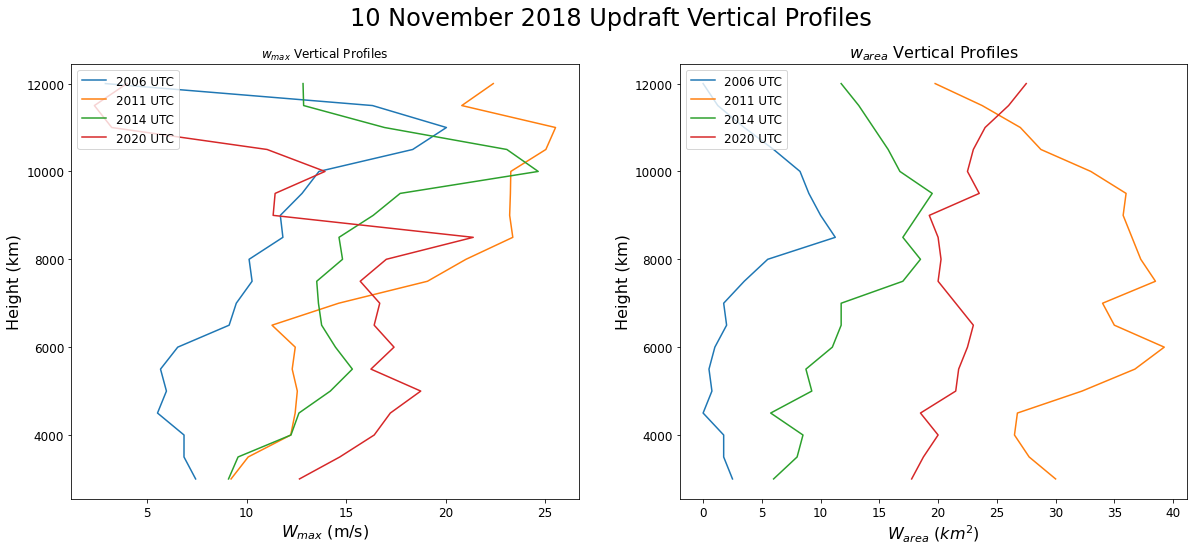
geo_df['times'] = pd.to_numeric(geo_df.index.strftime('%H%M')) + 1
geo_df = geo_df[geo_df.times <= 2021]
#geo_df['times'] = pd.to_numeric(geo_df.index.strftime('%H%M')) + 1
trop_temps = geo_df.tropopause_temperature.values
trop_height = geo_df.tropopause_height.values
ct_height = geo_df.cloudtop_height.values
ot_temp = geo_df.mintb.values
btd = ot_temp - trop_temps
depth = ct_height - trop_height
nov10_times = np.array([2007, 2012, 2014, 2021])
nov10_ua = [9., 48.25, 20.75, 26.25]
nov10_wmax = [13.63, 23.37, 24.65, 21.39]
times = geo_df.times
ticks = np.arange(2007, 2022, 1)
times - 1
time
2018-11-10 20:07:55.000000512 2007
2018-11-10 20:08:55.000000512 2008
2018-11-10 20:11:55.000000512 2011
2018-11-10 20:12:55.000000512 2012
2018-11-10 20:13:55.000000512 2013
2018-11-10 20:14:55.000000512 2014
2018-11-10 20:15:55.000000512 2015
2018-11-10 20:16:55.000000512 2016
2018-11-10 20:17:55.000000512 2017
2018-11-10 20:18:55.000000512 2018
2018-11-10 20:19:55.000000512 2019
2018-11-10 20:20:55.000000512 2020
Name: times, dtype: int64
plt.figure(figsize=(16,9))
ax = plt.subplot(311)
ota = geo_df.area_circle_polygon
times = geo_df.times
ax.plot(geo_df.times, ota, linewidth=3, color='black')
max_ota = ota.max()
ind = np.where(ota == max_ota)[0][0]
#plt.axhline(ota[ind], linestyle='--', label=f'Max OTA {round(float(max_ota), 2)} $km^{2}$',
# color='k', linewidth=3)
#ax.scatter(df_sub.datetime, df_sub.area_polygon, s=80, color='black')
plt.yticks(fontsize=12)
plt.xticks(ticks, fontsize=12)
plt.ylabel('OTA \n $km^{2}$', fontsize=16)
ax_1 = plt.twinx()
ax_1.scatter(nov10_times, nov10_ua, linewidth=3, color='tab:blue', linestyle='-', label='Tropopause Height', s=50)
#ax_1.plot(geo_df.times, ota*.4032, linewidth=3, color='tab:blue', linestyle=':')
plt.ylabel('Updraft Area \n $km^{2}$', fontsize=16, color='tab:blue')
plt.xlabel('Time', fontsize=16)
plt.yticks(fontsize=12, color='tab:blue')
plt.yticks(fontsize=12)
plt.xticks(fontsize=12)
plt.xlim(2006, 2022)
#plt.legend(loc='lower left', fontsize=16)
ax2 = plt.subplot(312)
ax2.plot(times, btd, linewidth=3, color='black', linestyle='-', label='BTD')
#ax2.plot(times, ot_temp, linewidth=3, color='blue')
plt.yticks(fontsize=12)
plt.xticks(ticks, fontsize=12)
plt.xlim(2006, 2022)
#ax2.scatter(df_sub.datetime, df_sub.mintb, s=80, color='black')
plt.ylabel('Min IR - Trop Temp \n $K$', fontsize=16)
ax3 = plt.subplot(313)
ax3.plot(times, depth, linewidth=3, color='black', linestyle='-', label='Tropopause Height')
#ax3.plot(times, ct_height, linewidth=3, color='red')
#ax3.scatter(df_sub.datetime, df_sub.cloudtop_height.values[0], s=80, color='black')
plt.ylabel('OT Depth \n $km$', fontsize=16)
plt.xlabel('Time (UTC)', fontsize=16)
plt.yticks(fontsize=12)
plt.xticks(ticks, fontsize=12)
ax_3 = ax3.twinx()
ax_3.scatter(nov10_times, nov10_wmax, linewidth=3, color='tab:red', linestyle='-', label='Tropopause Height', s=50)
plt.ylabel('Max Updraft Speed \n $m/s$', fontsize=16, color='tab:red')
plt.xlabel('Time (UTC)', fontsize=16)
plt.yticks(fontsize=12, color='tab:red')
plt.xticks(fontsize=12, color='tab:red')
plt.xlim(2006, 2022)
#plt.legend(loc='lower left', fontsize=16)
#ax4 = plt.subplot(514)
#ax4.plot(nov12_times, nov12_ua, linewidth=3, color='tab:blue', linestyle='-', label='Tropopause Height')
#ax3.plot(times, ct_height, linewidth=3, color='red')
#plt.ylabel('Updraft Area \n $km^{2}$', fontsize=16)
#plt.xlabel('Time', fontsize=16)
#ax4 = plt.subplot(515)
#ax4.plot(nov12_times, nov12_wmax, linewidth=3, color='tab:green', linestyle='-', label='Tropopause Height')
#ax3.plot(times, ct_height, linewidth=3, color='red')
#plt.ylabel('Max Updraft Speed \n $m/s$', fontsize=16)
#plt.xlabel('Time', fontsize=16)
#plt.suptitle(f'10 November 2018 Supercell \n {df_sub.datetime.values[0]} UTC', fontsize=24)
#plt.savefig(f'compare_plots/time_series_{timestamp}.png', dpi=200)
#plt.suptitle()
plt.tight_layout()
plt.savefig('10_November_Time_Series.png', dpi=300)
plt.show()
plt.close()
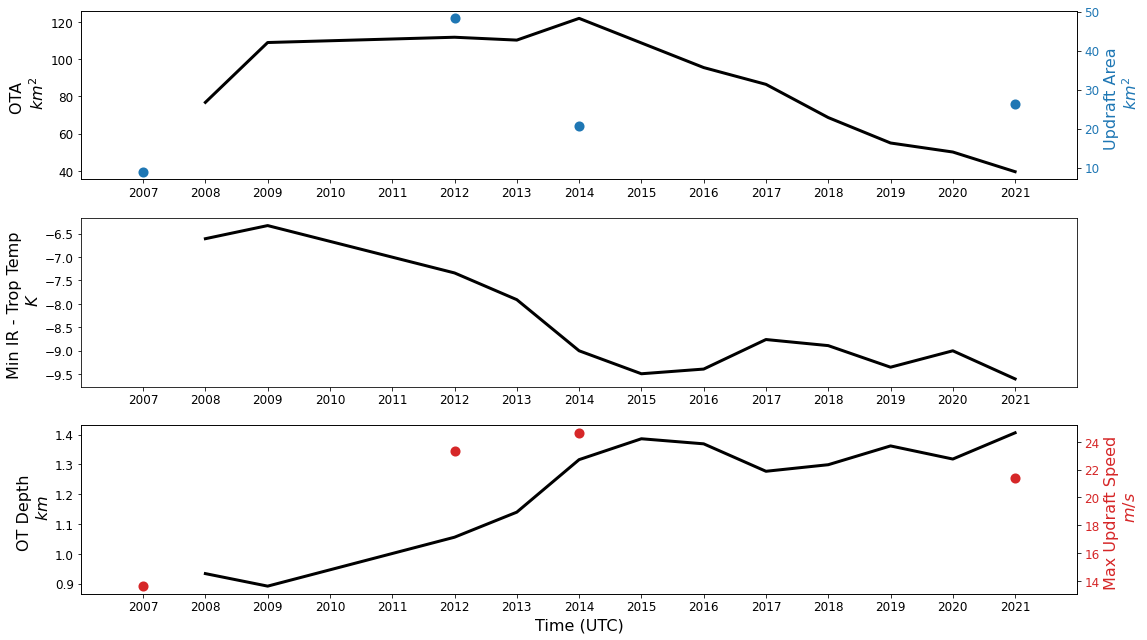
import numpy as np
import matplotlib.pyplot as plt
w = np.array([60.75, 21.5, 26.25])
ota = np.array([111.81, 121.94, 42.94])
times = np.array([2012, 2014, 2020])
plt.figure(figsize=(10,8))
ax = plt.subplot(111)
ax.plot(times, w, color='blue', linewidth=3, label='Midlevel Updraft Area (5-10 km)')
plt.legend(loc='lower left')
plt.xlabel('Time (UTC)')
plt.ylabel('Updraft Area (km2)', fontsize=16)
plt.yticks(fontsize=12)
ax2 = ax.twinx()
ax2.plot(times, ota, color='red', linewidth=3, label='OT Area (km2)')
plt.xlabel('Time (UTC)', fontsize=16)
plt.ylabel('OT Area (km2)', fontsize=16)
plt.yticks(fontsize=12)
plt.title('Midlevel Updraft Area and OT Area \n 10 November 2018 2012-2020 UTC', fontsize=24)
plt.legend()
<matplotlib.legend.Legend at 0x7f90b74dd750>
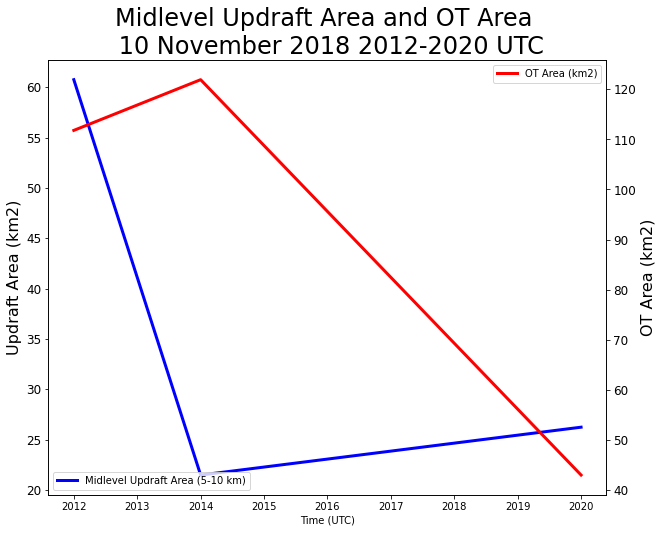
nov_10_peak_area = np.max(w)
nov_10_peak_ota = np.max(ota)
print(nov_10_peak_area, nov_10_peak_ota)
60.75 121.94
13-14 December Case¶
df= pd.read_csv('ot_output/Revised_OTs_14_Dec_2018_0214_0225.csv', index_col='time', parse_dates=True)
df['ot_depth'] = df.cloudtop_height - df.tropopause_height
ds = xr.open_dataset('dual_output/Dec13_new/Dec13_0217.nc').squeeze()
df['minute'] = df.index.minute
from shapely import wkt
df['geometry'] = df['geometry'].apply(wkt.loads)
geo_df = gpd.GeoDataFrame(df, geometry='geometry')
df_sub = geo_df[df.minute == 16]
ot_df = df_sub[df_sub.lat == df_sub.lat.values[0]]
ota = ot_df.area_circle_polygon.values
ot_lon = ot_df.centroid.x.values[0]
ot_lat = ot_df.centroid.y.values[0]
shift_x = ot_df.lon_corr.values[0] - ot_lon
shift_y = ot_df.lat_corr.values[0] - ot_lat
ot_df = ot_df.translate(shift_x, shift_y)
lats = ds.lat.values
lons = ds.lon.values
w_vals = ds.where((ds.w > 0) & (ds.lat > -31.848) & (ds.lat < -31.75) & (ds.lon > -64.45) & (ds.lon < -64.34)).sel(z=slice(3000, 12000)).w
ds_w = ds.where((ds.w > 0) & (ds.lat > -31.848) & (ds.lat < -31.75) & (ds.lon > -64.45) & (ds.lon < -64.34)).sel(z=slice(5000, 10000)).w.mean(dim='z').values
ds_wmax = ds.where((ds.w > 0) & (ds.lat > -31.848) & (ds.lat < -31.75) & (ds.lon > -64.45) & (ds.lon < -64.34)).sel(z=slice(3000, 12000)).w.max(dim=['x','y'])
ref = ds.where(ds.ZM_composite > -5).sel(z=1500).ZM_composite.values
w_max_list = []
w_area_list = []
areas, levels = calc_updraft_area(w_vals, 9)
w_area_list.append(xr.DataArray(areas, coords={'z':levels,
'time':ds_wmax.time}, dims={'z':levels}))
w_max_list.append(ds_wmax)
np.nanmax(ds_wmax)
/Users/mgrover/miniconda3/envs/unidata/lib/python3.7/site-packages/ipykernel_launcher.py:15: RuntimeWarning: invalid value encountered in greater
from ipykernel import kernelapp as app
33.699421025179255
w_vals = ds.where((ds.w > 0)).sel(z=slice(5000, 10000)).w.mean(dim='z').fillna(0).values
w = ds_w
updraft_area = len(w[np.where(ds_w > 9)]) * .25
w_mean = np.nanmean(w[np.where(ds_w > 9)])
/Users/mgrover/miniconda3/envs/unidata/lib/python3.7/site-packages/ipykernel_launcher.py:1: RuntimeWarning: invalid value encountered in greater
"""Entry point for launching an IPython kernel.
/Users/mgrover/miniconda3/envs/unidata/lib/python3.7/site-packages/ipykernel_launcher.py:2: RuntimeWarning: invalid value encountered in greater
w[np.where(ds_w > 9)]
/Users/mgrover/miniconda3/envs/unidata/lib/python3.7/site-packages/ipykernel_launcher.py:1: RuntimeWarning: invalid value encountered in greater
"""Entry point for launching an IPython kernel.
array([ 9.27682878, 17.35000961, 13.98963072, 9.19823161, 14.65811561,
13.8433275 , 10.5740579 , 12.56915881, 16.75180319, 20.95796565,
21.42135826, 17.358596 , 12.92547687, 9.43874279, 10.72486157,
13.50187222, 20.35497954, 21.1241165 , 19.40954137, 14.52802601,
9.11925453, 11.56321234, 18.64645158, 18.75561175, 14.52491434,
11.31667959, 10.17463817, 12.32169494, 12.55943408, 19.21351158,
21.19138609, 15.26660814, 16.47336712, 19.21252224, 21.21332974,
21.04318716, 11.27369554, 10.69152069, 13.57239195, 20.3514361 ,
23.83480757, 23.57636473, 22.59575899, 11.78564587, 13.20858526,
18.56239851, 20.55815508, 18.28618062, 12.98505501, 12.14690831,
13.81652015])
w = np.nan_to_num(w)
ds_sub = ds.sel(z=1500)
ax = plt.subplot(111, projection=ccrs.PlateCarree())
u_wnd = ds_sub.u.values
v_wnd = ds_sub.v.values
w_wnd = ds_sub.w.values
lons, lats = np.meshgrid(ds.lon.values, ds.lat.values)
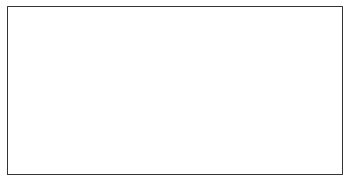
fig = plt.figure(figsize=(12,8))
ax = plt.subplot(111, projection=ccrs.PlateCarree())
cf = plt.pcolormesh(lons, lats,ref , vmin=10, vmax=50, cmap='pyart_Carbone17')
cb1 = plt.colorbar(cf, label='Reflectivity (dBZ)', shrink=.7)
cb1.set_label('Reflectivity (dBZ)', fontsize=16)
cb1.ax.tick_params(labelsize=16)
w_mask = w
cf = plt.contour(lons, lats, w_mask , levels=[9, 30], colors=['black'], linestyles='--', linewidth=3)
#cb = plt.colorbar(cf, shrink=.7)
#cb.set_label('Vertical Velocity (m/s)', fontsize=16)
cb1.ax.tick_params(labelsize=16)
ot_df.plot(ax=ax, facecolor="none",
edgecolor='black',linewidth=3, label='otarea')
gl = ax.gridlines(crs=ccrs.PlateCarree(), draw_labels=True,
linewidth=2, color='gray', alpha=0.5, linestyle='--')
gl.top_labels = False
gl.left_labels= True
gl.right_labels = False
gl.xlabel_style = {'size': 16, 'color': 'k'}
gl.ylabel_style = {'size': 16, 'color': 'k'}
ax.set_extent((-64.5, -64.1, -31.9, -31.5))
plt.plot(0,0, color='black', label=f'OT Area: {ota[0].round(2)} $km^{2}$ ', linewidth=3)
plt.plot(0,0, color='black', label=f'Updraft Area: {updraft_area} $km^{2}$', linewidth=3, linestyle='--')
plt.legend(loc='upper left', fontsize=14)
plt.title('Reflectivty at 1.5 km \n and Mean Updraft 5-10 km \n 13 December 2018 2017 UTC', fontsize=16)
plt.savefig('summary_figs/Dec_14_0217.png', dpi=400)
/Users/mgrover/miniconda3/envs/unidata/lib/python3.7/site-packages/cartopy/mpl/geoaxes.py:1478: UserWarning: The following kwargs were not used by contour: 'linewidth'
result = matplotlib.axes.Axes.contour(self, *args, **kwargs)
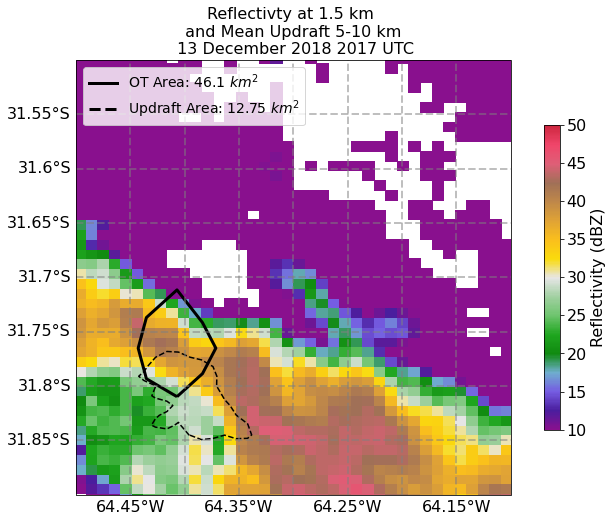
14 December 2018 2020 UTC¶
df= pd.read_csv('ot_output/Revised_OTs_14_Dec_2018_0214_0225.csv', index_col='time', parse_dates=True)
df.area_circle_polygon
time
2018-12-14 02:15:25.000000512 40.137743
2018-12-14 02:16:25.000000512 46.100451
2018-12-14 02:17:25.000000512 39.036624
2018-12-14 02:18:25.000000512 69.240941
2018-12-14 02:19:25.000000512 74.079337
2018-12-14 02:20:25.000000512 67.684649
2018-12-14 02:21:25.000000512 64.809910
2018-12-14 02:22:25.000000512 51.882368
2018-12-14 02:23:25.000000512 56.217753
2018-12-14 02:24:25.000000512 37.921218
2018-12-14 02:25:25.000000512 38.579593
2018-12-14 02:26:25.000000512 48.283925
Name: area_circle_polygon, dtype: float64
ds = xr.open_dataset('dual_output/Dec13/Dec13_0220.nc').squeeze()
df['minute'] = df.index.minute
df_sub = geo_df[df.minute == 21]
ot_df = df_sub[df_sub.lat == df_sub.lat.values[0]]
ota = ot_df.area_circle_polygon.values
ot_lon = ot_df.centroid.x.values[0]
ot_lat = ot_df.centroid.y.values[0]
shift_x = ot_df.lon_corr.values[0] - ot_lon
shift_y = ot_df.lat_corr.values[0] - ot_lat
ot_df = ot_df.translate(shift_x, shift_y)
lats = ds.lat.values
lons = ds.lon.values
w_vals = ds.where((ds.w > 0) & (ds.lat > -31.9) & (ds.lat < -31.75) & (ds.lon > -64.4) & (ds.lon < -64.33)).sel(z=slice(3000, 12000)).w
ds_w = ds.where((ds.w > 0) & (ds.lat > -31.9) & (ds.lat < -31.75) & (ds.lon > -64.4) & (ds.lon < -64.33)).sel(z=slice(5000, 10000)).w.mean(dim='z').values
ds_wmax = ds.where((ds.w > 0) & (ds.lat > -31.9) & (ds.lat < -31.75) & (ds.lon > -64.4) & (ds.lon < -64.33)).sel(z=slice(3000, 12000)).w.max(dim=['x','y'])
ref = ds.where(ds.ZM_composite > -5).sel(z=1500).ZM_composite.values
w_max_list.append(ds_wmax)
areas, levels = calc_updraft_area(w_vals, 9)
w_area_list.append(xr.DataArray(areas, coords={'z':levels,
'time':ds_wmax.time}, dims={'z':levels}))
np.nanmax(ds_wmax)
/Users/mgrover/miniconda3/envs/unidata/lib/python3.7/site-packages/ipykernel_launcher.py:15: RuntimeWarning: invalid value encountered in greater
from ipykernel import kernelapp as app
26.627381567116956
w_vals = ds.where((ds.w > 0)).sel(z=slice(6000, 10000)).w.mean(dim='z').values
w = ds_w
updraft_area = len(w[np.where(ds_w > 8)]) * .25
w_mean = np.nanmean(w[np.where(ds_w > 8)])
/Users/mgrover/miniconda3/envs/unidata/lib/python3.7/site-packages/ipykernel_launcher.py:1: RuntimeWarning: invalid value encountered in greater
"""Entry point for launching an IPython kernel.
/Users/mgrover/miniconda3/envs/unidata/lib/python3.7/site-packages/ipykernel_launcher.py:2: RuntimeWarning: invalid value encountered in greater
print(w_mean)
11.13791089381304
fig = plt.figure(figsize=(12,8))
ax = plt.subplot(111, projection=ccrs.PlateCarree())
cf = plt.pcolormesh(lons, lats,ref , vmin=10, vmax=50, cmap='pyart_Carbone17')
cb1 = plt.colorbar(cf, shrink=.7)
cb1.set_label('Reflectivity (dBZ)', fontsize=16)
cb1.ax.tick_params(labelsize=16)
#q = ax.quiver(lons[::2], lats[::2], u_wnd[::2], v_wnd[::2], pivot='mid', color='black', scale=50, scale_units='inches')
#ax.quiverkey(q, X=.95, Y=.1, U=10, label='10 m/s', labelpos='W')
w_mask = np.nan_to_num(w)
cf = plt.contour(lons, lats, w_mask , levels=[9,30], colors=['black'], linestyles='--', linewidth=3)
#cb = plt.colorbar(cf, shrink=.7)
#cb.set_label('Vertical Velocity (m/s)', fontsize=16)
cb1.ax.tick_params(labelsize=16)
ot_df.plot(ax=ax, facecolor="none",
edgecolor='black',linewidth=3, label='otarea')
gl = ax.gridlines(crs=ccrs.PlateCarree(), draw_labels=True,
linewidth=2, color='gray', alpha=0.5, linestyle='--')
gl.top_labels = False
gl.left_labels= True
gl.right_labels = False
gl.xlabel_style = {'size': 16, 'color': 'k'}
gl.ylabel_style = {'size': 16, 'color': 'k'}
ax.set_extent((-64.5, -64.1, -31.9, -31.5))
plt.plot(0,0, color='black', label=f'OT Area: {ota[0].round(2)} $km^{2}$ ', linewidth=3)
plt.plot(0,0, color='black', label=f'Updraft Area: {updraft_area} $km^{2}$', linewidth=3, linestyle='--')
plt.legend(loc='upper left', fontsize=14)
plt.title('Reflectivity at 1.5 km \n and Mean Updraft 5-10 km \n 13 December 2018 2022 UTC', fontsize=16)
plt.savefig('summary_figs/Dec_14_0222.png', dpi=400)
/Users/mgrover/miniconda3/envs/unidata/lib/python3.7/site-packages/cartopy/mpl/geoaxes.py:1478: UserWarning: The following kwargs were not used by contour: 'linewidth'
result = matplotlib.axes.Axes.contour(self, *args, **kwargs)
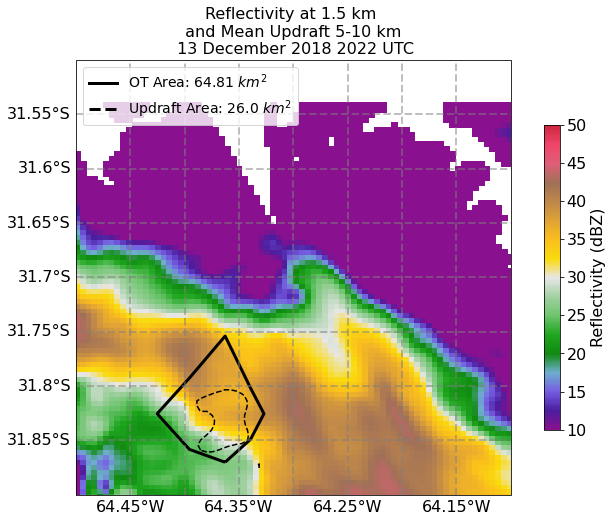
#geo_df['times'] = pd.to_numeric(geo_df.index.strftime('%H%M'))
geo_df['times'] = pd.to_numeric(geo_df.index.strftime('%H%M'))
geo_df = geo_df[geo_df.times <= 226]
trop_temps = geo_df.tropopause_temperature.values
trop_height = geo_df.tropopause_height.values
ct_height = geo_df.cloudtop_height.values
ot_temp = geo_df.mintb.values
btd = ot_temp - trop_temps
depth = ct_height - trop_height
dec14_times = np.array([216, 221, 226])
dec14_ua = [38., 26., 16.25]
dec14_wmax = [27.52, 26.03, 25.21]
ticks = np.arange(215, 227, 1)
plt.figure(figsize=(16,9))
ax = plt.subplot(311)
ota = geo_df.area_circle_polygon
times = geo_df.times
ax.plot(geo_df.times, ota, linewidth=3, color='black')
max_ota = ota.max()
ind = np.where(ota == max_ota)[0][0]
#plt.axhline(ota[ind], linestyle='--', label=f'Max OTA {round(float(max_ota), 2)} $km^{2}$',
# color='k', linewidth=3)
#ax.scatter(df_sub.datetime, df_sub.area_polygon, s=80, color='black')
plt.yticks(fontsize=12)
plt.xticks(ticks, fontsize=12)
plt.ylabel('OTA \n $km^{2}$', fontsize=16)
ax_1 = plt.twinx()
ax_1.scatter(dec14_times, dec14_ua, linewidth=3, color='tab:blue', linestyle='-', label='Observed Updraft Area', s=50)
#ax_1.plot(geo_df.times, ota*.4032, linewidth=3, color='tab:blue', linestyle=':', label='OTA Derived Updraft Area')
plt.ylabel('Updraft Area \n $km^{2}$', fontsize=16, color='tab:blue')
plt.xlabel('Time', fontsize=16)
plt.yticks(fontsize=12, color='tab:blue')
plt.xticks(fontsize=12)
ax2 = plt.subplot(312)
ax2.plot(geo_df.times, btd, linewidth=3, color='black', linestyle='-', label='BTD')
#ax2.plot(times, ot_temp, linewidth=3, color='blue')
plt.yticks(fontsize=12)
plt.xticks(ticks, fontsize=12)
#ax2.scatter(df_sub.datetime, df_sub.mintb, s=80, color='black')
plt.ylabel('Min IR - Trop Temp \n $K$', fontsize=16)
ax3 = plt.subplot(313)
ax3.plot(geo_df.times, depth, linewidth=3, color='black', linestyle='-', label='Tropopause Height')
#ax3.plot(times, ct_height, linewidth=3, color='red')
#ax3.scatter(df_sub.datetime, df_sub.cloudtop_height.values[0], s=80, color='black')
plt.ylabel('OT Depth \n $km$', fontsize=16)
plt.xlabel('Time (UTC)', fontsize=16)
plt.yticks(fontsize=12)
plt.xticks(ticks, fontsize=12)
ax_3 = ax3.twinx()
ax_3.scatter(dec14_times, dec14_wmax, linewidth=3, color='tab:red', linestyle='-', label='Tropopause Height', s=50)
plt.ylabel('Max Updraft Speed \n $m/s$', fontsize=16, color='tab:red')
plt.xlabel('Time (UTC)', fontsize=16)
plt.yticks(fontsize=12, color='tab:red')
plt.xticks(fontsize=12, color='tab:red')
#plt.legend(loc='lower left', fontsize=16)
#ax4 = plt.subplot(514)
#ax4.plot(nov12_times, nov12_ua, linewidth=3, color='tab:blue', linestyle='-', label='Tropopause Height')
#ax3.plot(times, ct_height, linewidth=3, color='red')
#plt.ylabel('Updraft Area \n $km^{2}$', fontsize=16)
#plt.xlabel('Time', fontsize=16)
#ax4 = plt.subplot(515)
#ax4.plot(nov12_times, nov12_wmax, linewidth=3, color='tab:green', linestyle='-', label='Tropopause Height')
#ax3.plot(times, ct_height, linewidth=3, color='red')
#plt.ylabel('Max Updraft Speed \n $m/s$', fontsize=16)
#plt.xlabel('Time', fontsize=16)
#plt.suptitle(f'10 November 2018 Supercell \n {df_sub.datetime.values[0]} UTC', fontsize=24)
#plt.savefig(f'compare_plots/time_series_{timestamp}.png', dpi=200)
#plt.suptitle()
plt.tight_layout()
plt.savefig('14_December_Time_Series.png', dpi=300)
plt.show()
plt.close()

geo_df[geo_df.minute < 25].area_circle_polygon.plot()
<matplotlib.axes._subplots.AxesSubplot at 0x7fdaf45639d0>
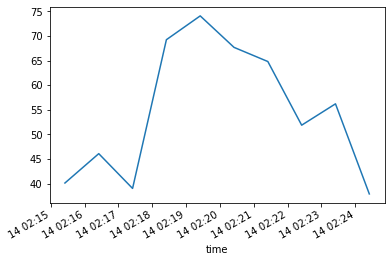
geo_df[geo_df.minute < 25].cloudtop_height.plot()
geo_df[geo_df.minute < 25].tropopause_height.plot()
<matplotlib.axes._subplots.AxesSubplot at 0x7fdafa852450>
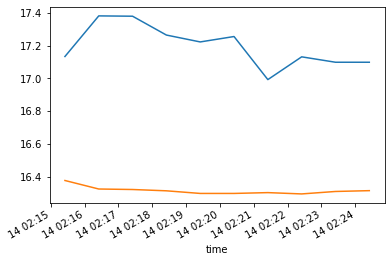
14 December 2025 UTC¶
df= pd.read_csv('ot_output/Revised_OTs_14_Dec_2018_0214_0225.csv', index_col='time', parse_dates=True)
ds = xr.open_dataset('dual_output/Dec14/Dec14_0225.nc').squeeze()
df['minute'] = df.index.minute
df_sub = geo_df[df.minute == 25]
ot_df = df_sub[df_sub.lat == df_sub.lat.values[0]]
ota = ot_df.area_circle_polygon.values
ot_lon = ot_df.centroid.x.values[0]
ot_lat = ot_df.centroid.y.values[0]
shift_x = ot_df.lon_corr.values[0] - ot_lon
shift_y = ot_df.lat_corr.values[0] - ot_lat
ot_df = ot_df.translate(shift_x, shift_y)
lats = ds.lat.values
lons = ds.lon.values
w_vals = ds.where((ds.w > 0) & (ds.lat > -31.935) & (ds.lat < -31.8) & (ds.lon > -64.4) & (ds.lon < -64.18)).sel(z=slice(3000, 12000)).w
ds_w = ds.where((ds.w > 0) & (ds.lat > -31.935) & (ds.lat < -31.8) & (ds.lon > -64.4) & (ds.lon < -64.18)).sel(z=slice(5000, 10000)).w.mean(dim='z').values
ds_wmax = ds.where((ds.w > 0) & (ds.lat > -31.935) & (ds.lat < -31.8) & (ds.lon > -64.4) & (ds.lon < -64.18)).sel(z=slice(3000, 12000)).w.max(dim=['x','y'])
ref = ds.where(ds.ZM_composite > -5).sel(z=1500).ZM_composite.values
w_max_list.append(ds_wmax)
np.nanmax(ds_wmax)
areas, levels = calc_updraft_area(w_vals, 9)
w_area_list.append(xr.DataArray(areas, coords={'z':levels,
'time':ds_wmax.time}, dims={'z':levels}))
/Users/mgrover/miniconda3/envs/unidata/lib/python3.7/site-packages/ipykernel_launcher.py:15: RuntimeWarning: invalid value encountered in greater
from ipykernel import kernelapp as app
w_vals = ds.where((ds.w > 0)).sel(z=slice(6000, 10000)).w.mean(dim='z').values
w = ds_w
updraft_area = len(w[np.where(ds_w > 9)]) * .25
/Users/mgrover/miniconda3/envs/unidata/lib/python3.7/site-packages/ipykernel_launcher.py:1: RuntimeWarning: invalid value encountered in greater
"""Entry point for launching an IPython kernel.
w_mean = np.nanmean(w[np.where(ds_w > 9)])
/Users/mgrover/miniconda3/envs/unidata/lib/python3.7/site-packages/ipykernel_launcher.py:1: RuntimeWarning: invalid value encountered in greater
"""Entry point for launching an IPython kernel.
w_mean
12.867797103604888
fig = plt.figure(figsize=(12,8))
ax = plt.subplot(111, projection=ccrs.PlateCarree())
cf = plt.pcolormesh(lons, lats,ref , vmin=10, vmax=50, cmap='pyart_Carbone17')
cb1 = plt.colorbar(cf, label='Reflectivity (dBZ)', shrink=.7)
cb1.set_label('Reflectivity (dBZ)', fontsize=16)
cb1.ax.tick_params(labelsize=16)
w_mask = np.nan_to_num(w)
cf = plt.contour(lons, lats, w_mask , levels=[9,30], colors=['black'], linestyles='--', linewidth=3)
#cb = plt.colorbar(cf, shrink=.7)
#cb.set_label('Vertical Velocity (m/s)', fontsize=16)
cb1.ax.tick_params(labelsize=16)
ot_df.plot(ax=ax, facecolor="none",
edgecolor='black',linewidth=3, label='otarea')
gl = ax.gridlines(crs=ccrs.PlateCarree(), draw_labels=True,
linewidth=2, color='gray', alpha=0.5, linestyle='--')
gl.top_labels = False
gl.left_labels= True
gl.right_labels = False
gl.xlabel_style = {'size': 16, 'color': 'k'}
gl.ylabel_style = {'size': 16, 'color': 'k'}
ax.set_extent((-64.5, -64.1, -31.9, -31.5))
plt.plot(0,0, color='black', label=f'OT Area: {ota[0].round(2)} $km^{2}$ ', linewidth=3)
plt.plot(0,0, color='black', label=f'Updraft Area: {updraft_area} $km^{2}$', linewidth=3, linestyle='--')
plt.legend(loc='upper left', fontsize=14)
plt.title('Reflectivty at 1.5 km \n and Mean Updraft 5-10 km \n 13 December 2018 2027 UTC', fontsize=16)
plt.savefig('summary_figs/Dec_14_0227.png', dpi=400)
/Users/mgrover/miniconda3/envs/unidata/lib/python3.7/site-packages/cartopy/mpl/geoaxes.py:1478: UserWarning: The following kwargs were not used by contour: 'linewidth'
result = matplotlib.axes.Axes.contour(self, *args, **kwargs)
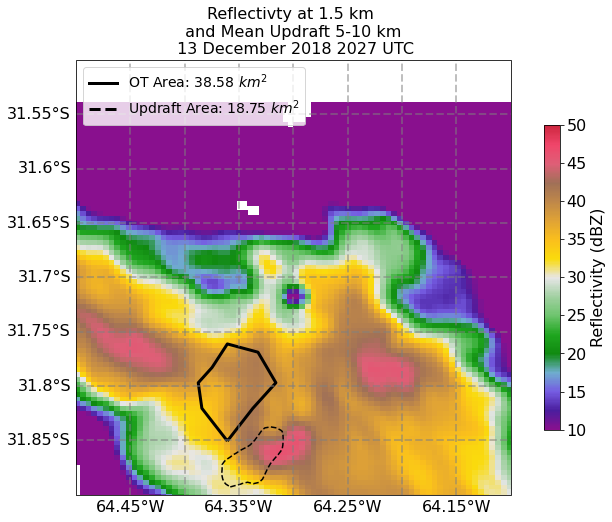
w = np.array([8.25, 6, 6])
ota = np.array([40.14, 67.68, 38.58])
times = np.array([2015, 2020, 2025])
plt.figure(figsize=(10,8))
ax = plt.subplot(111)
ax.plot(times, w, color='blue', linewidth=3, label='Midlevel Updraft Area (5-10 km)')
plt.legend(loc='upper left')
plt.xlabel('Time (UTC)')
plt.ylabel('Updraft Area (km2)', fontsize=16)
plt.yticks(fontsize=12)
plt.ylim(0,10)
ax2 = ax.twinx()
ax2.plot(times, ota, color='red', linewidth=3, label='OT Area (km2)')
plt.xlabel('Time (UTC)', fontsize=16)
plt.ylabel('OT Area (km2)', fontsize=16)
plt.yticks(fontsize=12)
plt.title('Midlevel Updraft Area and OT Area \n 14 December 2018 2015-2025 UTC', fontsize=24)
plt.ylim(0,100)
plt.legend()
<matplotlib.legend.Legend at 0x7fdad6a06ed0>
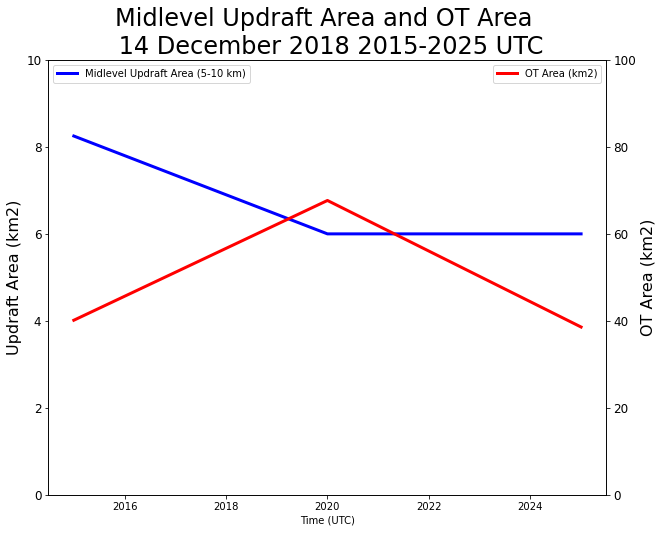
dec_14_peak_area = np.max(w)
dec_14_peak_ota = np.max(ota)
dec_14_peak_area
8.25
dec_14_peak_ota
67.68
ds_wmax = xr.concat(w_max_list, 'time')
ds_warea = xr.concat(w_area_list, 'time')
from datetime import timedelta
fig = plt.figure(figsize=(20,8))
colors = ['tab:blue', 'tab:orange', 'tab:green', 'tab:red']
for time in range(len(ds_wmax.time)):
ds_w = ds_wmax.isel(time=time)
ds_wa = ds_warea.isel(time=time)
mean_w = np.nanmean(ds_w)
max_w = np.nanmax(ds_w)
timestamp = int((pd.to_datetime(ds_w.time.values) + timedelta(minutes=2)).strftime('%H%M'))
ax = plt.subplot(121)
ax.plot(ds_w.values, ds_w.z, label=f'{timestamp} UTC', color=colors[time])
wmax = '$w_{max}$'
#ax.axvline(mean_w, label=f'Mean {wmax} in 5-10 km layer {np.round(mean_w, 2)} m/s', linestyle=':', color=colors[time])
#ax.axvline(max_w, label=f'Max {wmax} in 5-10 km layer {np.round(max_w, 2)} m/s', linestyle='--', color=colors[time])
plt.title('$w_{max}$ Vertical Profiles', fontsize=16)
plt.xticks(fontsize=12)
plt.yticks(fontsize=12)
plt.xlabel('$W_{max}$ (m/s)', fontsize=16)
plt.ylabel('Height (km)', fontsize=16)
plt.legend(loc='upper left', fontsize=12)
ax2 = plt.subplot(122)
ax2.plot(ds_wa.values, ds_wa.z, label=f'{timestamp} UTC', color=colors[time])
plt.title('$w_{area}$ Vertical Profiles', fontsize=16)
plt.xticks(fontsize=12)
plt.yticks(fontsize=12)
plt.xlabel('$W_{area}$ ($km^2$)', fontsize=16)
plt.ylabel('Height (km)', fontsize=16)
plt.legend(loc='upper left', fontsize=12)
plt.suptitle('14 December 2018 Updraft Vertical Profiles', fontsize=24)
plt.savefig('Vertical_w_prof_14_dec.png', dpi=400)
/Users/mgrover/miniconda3/envs/unidata/lib/python3.7/site-packages/ipykernel_launcher.py:12: MatplotlibDeprecationWarning: Adding an axes using the same arguments as a previous axes currently reuses the earlier instance. In a future version, a new instance will always be created and returned. Meanwhile, this warning can be suppressed, and the future behavior ensured, by passing a unique label to each axes instance.
if sys.path[0] == '':
/Users/mgrover/miniconda3/envs/unidata/lib/python3.7/site-packages/ipykernel_launcher.py:26: MatplotlibDeprecationWarning: Adding an axes using the same arguments as a previous axes currently reuses the earlier instance. In a future version, a new instance will always be created and returned. Meanwhile, this warning can be suppressed, and the future behavior ensured, by passing a unique label to each axes instance.
/Users/mgrover/miniconda3/envs/unidata/lib/python3.7/site-packages/ipykernel_launcher.py:12: MatplotlibDeprecationWarning: Adding an axes using the same arguments as a previous axes currently reuses the earlier instance. In a future version, a new instance will always be created and returned. Meanwhile, this warning can be suppressed, and the future behavior ensured, by passing a unique label to each axes instance.
if sys.path[0] == '':
/Users/mgrover/miniconda3/envs/unidata/lib/python3.7/site-packages/ipykernel_launcher.py:26: MatplotlibDeprecationWarning: Adding an axes using the same arguments as a previous axes currently reuses the earlier instance. In a future version, a new instance will always be created and returned. Meanwhile, this warning can be suppressed, and the future behavior ensured, by passing a unique label to each axes instance.
